Annual Report on Official Languages for Fiscal Year 2016 to 2017
The Official Languages Act (the act) requires that the President of the Treasury Board report to Parliament on the status of official languages programs in federal institutions subject to Parts IV, V and VI of the act.
The Office of the Chief Human Resources Officer (OCHRO) provides support for some 200 federal institutions subject to the act so that they can meet their obligations under the act. These institutions consist of those that are part of the core public administration, as well as Crown corporations, privatized organizations, separate agencies and other public institutions.
Deputy heads have the primary responsibility for human resources management in their organization. They must ensure that their institution:
- develops and maintains a corporate culture that is conducive to the use of both official languages
- has the capacity to communicate with the Canadian public and public servants in both official languages
- maintains a public service workforce that tends to reflect the two official language communities
This 29th annual report sets out the activities and accomplishments of federal institutions in meeting their official languages responsibilities for the 2016 to 2017 fiscal year.Footnote 1
On this page
- Message from the President of the Treasury Board
- Status of official languages programs
- Office of the Chief Human Resources Officer activities and follow-up
- Conclusion and trends
- Appendix A: Federal institutions required to submit a review for fiscal year 2016 to 2017
- Appendix B: Definitions
- Appendix C: Sources of statistical data
- Appendix D: Statistical tables
Message from the President of the Treasury Board

President of the Treasury Board
I am pleased to table in Parliament the 29th Annual Report on Official Languages for fiscal year 2016 to 2017. This report describes the government's efforts to promote and protect Canada's 2 official languages in the federal government.
Our official languages are at the core of a public service that reflects Canada's diversity. We have a solid legislative framework for our 2 official languages, including the Canadian Charter of Rights and Freedoms, the Official Languages Act, and the Official Languages Regulations, which are used to determine the language obligations of federal points of service.
The current Official Languages Regulations date back to 1991. Technological changes and Canada's new demographic reality were 2 key factors that led me to launch the review of the regulations in 2016. Our discussions with stakeholders from linguistic minorities across the country clearly demonstrated the desire for change. In order for a constructive consultation process to take place, I imposed a moratorium so that, until new and improved regulations are in place, services to the public will continue to be provided in both official languages at federal offices that were in the process of becoming unilingual.
In order to provide quality bilingual services to the public, we must strive to build and maintain a work environment where both our official languages flourish. We will support the efforts of the Clerk of the Privy Council to improve the equitable use of English and French in federal workplaces. We are determined to cultivate diversity and inclusion in the public service by attracting and hiring a broad range of competent, bilingual employees. We must foster inclusive linguistic duality in the public service, and make language training more accessible, so that we can design and offer programs and services that meet the needs and expectations of Canadians.
I invite you to read this report to learn about the scope of the Government of Canada's efforts to sustain and enhance our exemplary, bilingual federal administration.
Original signed by
The Honourable Scott Brison
President of the Treasury Board
Status of official languages programs
Offering official languages programs in federal organizations is a fundamental part of human resources management and delivering services to the Canadian public. Federal institutions must submit to OCHRO a review on official languages at least once every three years. The 2016 to 2017 fiscal year is the third in a three-year cycle. Fifty-five organizations had to complete a questionnaire on elements pertaining to the application of Parts IV, V and VI of the act.Footnote 2
Methodology
Institutions were required to report on the following elements:
- communications with and services to the public in both official languages
- language of work
- human resources management
- governance
- monitoring of official languages programs
These five elements were evaluated, mainly through the use of multiple-choice questions. To reduce the administrative burden on small institutions, theyFootnote 3 , were asked fewer questions than large and key institutions. Deputy heads are responsible for ensuring that their institution’s responses are supported by facts and evidence. The response scales used in the Review on Official Languages are shown in Table 1.
| Nearly always | In 90% or more of cases |
|---|---|
| Very often | Between 70% and 89% of cases |
| Often | Between 50% and 69% of cases |
| Sometimes | Between 25% and 49% of cases |
| Almost never | In less than 25% of cases |
| Yes | Completely agree with the statement |
| No | Completely disagree with the statement |
| Regularly | With some regularity |
| Sometimes | From time to time, but not regularly |
| Almost never | Rarely |
| N/A | Does not apply to the institution |
Narrative questions were used to gather more detailed information about various elements, including the following:
- institutions’ official languages capacity
- activities undertaken by large and key institutionsFootnote 4 to measure the availability and quality of services offered in both official languages
The information collected is also used for other activities of OCHRO.
The following sections provide an overview of the status of the official languages programs in the 55 institutions that submitted reviews. The statistical tables in Appendix D of this report show the results for all federal institutions.Footnote 5
In September 2016, the Office of the Commissioner of Official Languages released the results of a national telephone survey in which 96% of respondents indicated that Canadians should be able to receive federal government services in English or French and 88% expressed support for the objectives of the Official Languages Act. The survey was conducted by Nielsen on behalf of the Office of the Commissioner of Official Languages from February to March 2016. The results have a margin of error of +/-3.1%, 19 times out of 20.
Communications with and services to the public
As of , federal institutions had 11,330 offices,Footnote 6 , 3,867 (34.1%) of which were required to offer services to and communicate with the public in both official languages.
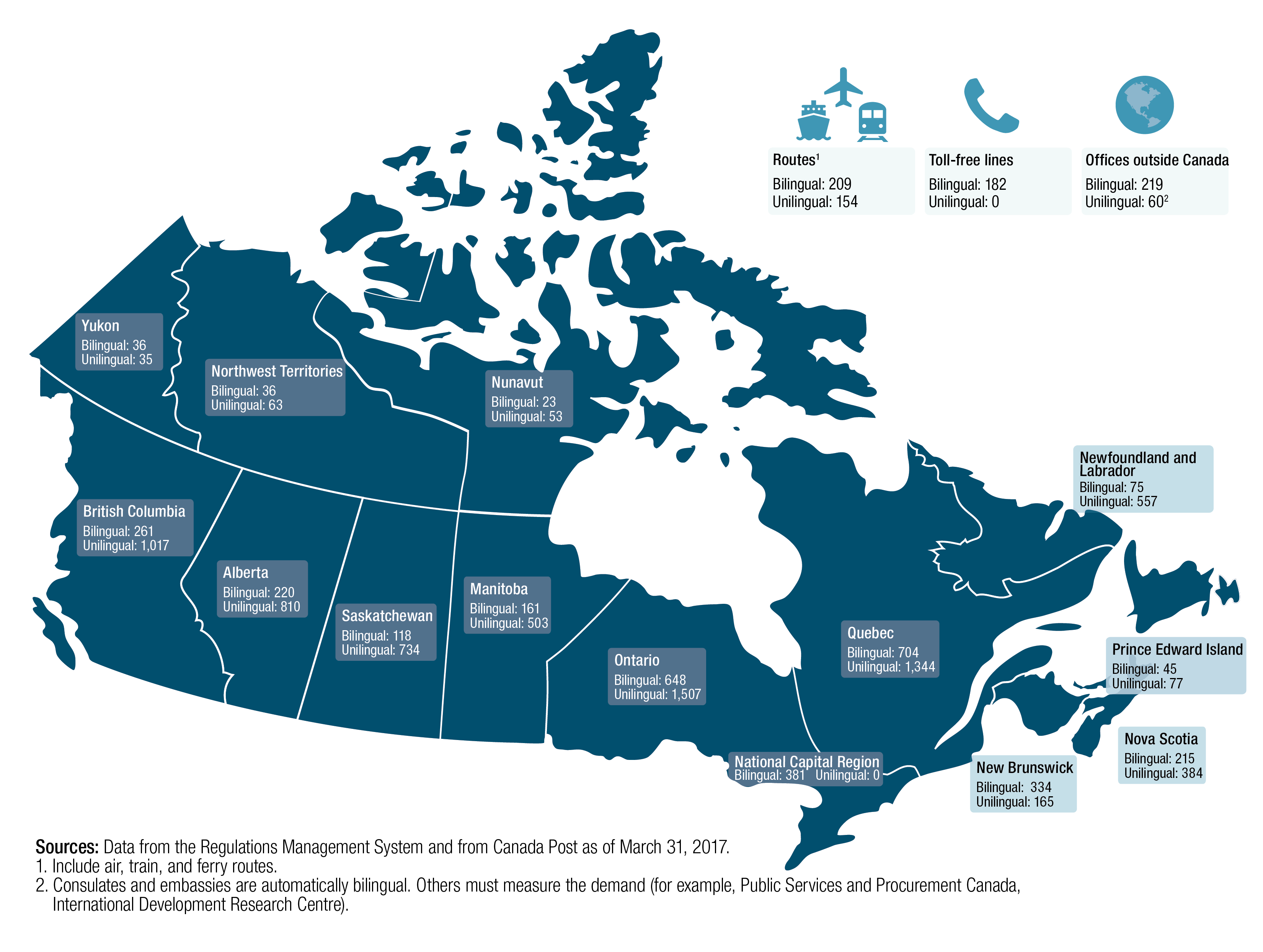
Map - Text version
British Columbia: 261 bilingual offices, 1,017 unilingual; Alberta: 220 bilingual offices, 810 unilingual; Saskatchewan: 118 bilingual offices, 734 unilingual; Manitoba: 161 bilingual offices, 503 unilingual; Ontario: 648 bilingual offices, 1,507 unilingual; National Capital Region: 381 bilingual offices, none unilingual; Quebec: 704 bilingual offices, 1,344 unilingual; New Brunswick: 334 bilingual offices, 165 unilingual; Prince Edward Island: 45 bilingual offices, 77 unilingual; Nova Scotia: 215 bilingual offices, 384 unilingual; Newfoundland and Labrador: 75 bilingual offices, 557 unilingual; Yukon: 36 bilingual offices, 35 unilingual; Northwest Territories: 36 bilingual offices, 63 unilingual; Nunavut: 23 bilingual offices, 53 unilingual; Offices outside Canada: 219 bilingual, 60 unilingual (Consulates and embassies are automatically bilingual. Other offices must measure the demand (for example, Public Services and Procurement Canada, International Development Research Centre)); 182 bilingual toll free lines, none are unilingual; Routes: 209 bilingual, 154 unilingual (include air, train and ferry routes). Sources: Data from the Regulatory Management System and from Canada Post as of March 31, 2017.
Frequency of oral and written communications
Based on the reviews for fiscal year 2016 to 2017, almost all of the institutions that were assessed (96%) reported that, in offices that are bilingual for the purposes of communications with and services to the public, oral communications nearly always or very often occur in the official language chosen by the public. For small institutions, this percentage is also 96%.
Ninety-eight percent of the institutions said that written communications nearly always or very often occur in the official language chosen by the public. In small institutions, the percentage is 96%.
Figure 1. Institutions’ responses for the frequency of oral and written communications in the official language chosen by the public when the office is bilingual
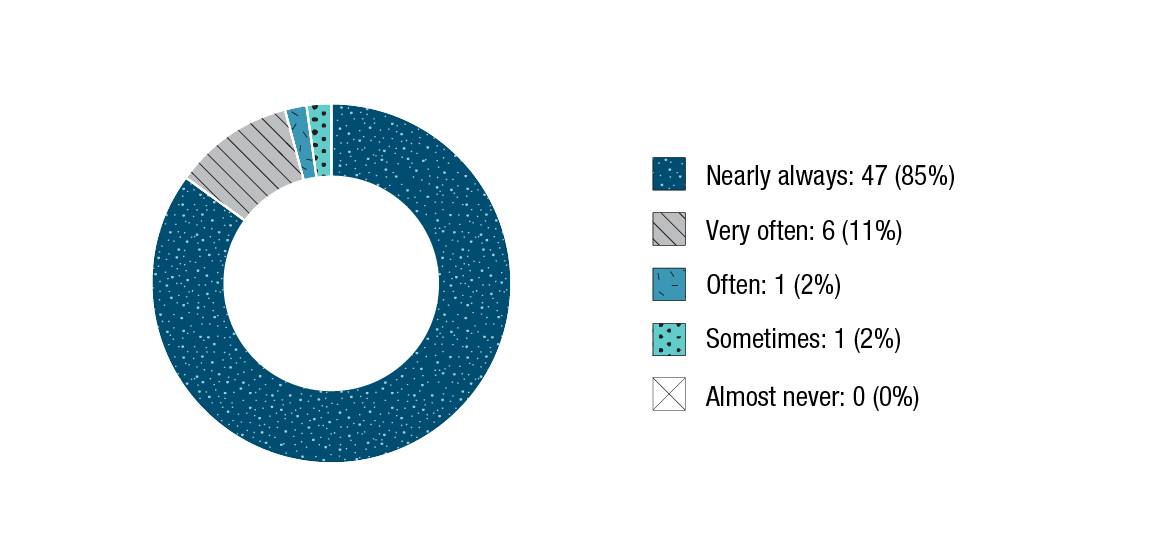
Figure 1a - Text version
| Nearly always | Very often | Often | Sometimes | Almost never | |
|---|---|---|---|---|---|
| Amount | 47 | 6 | 1 | 1 | 0 |
| Percentage (%) | 85% | 11% | 2% | 2% | 0% |
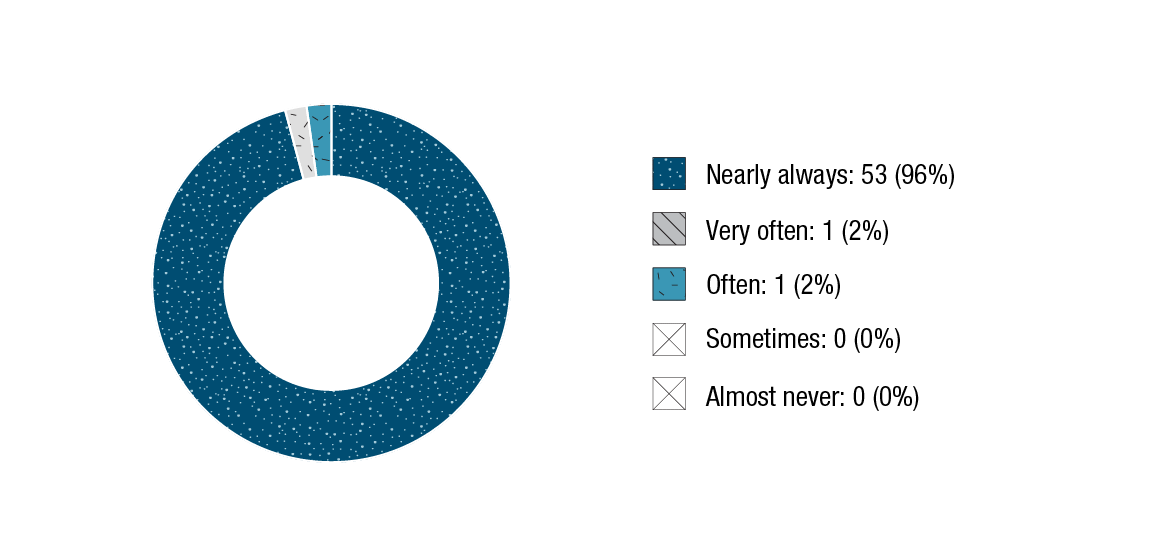
Figure 1b - Text version
| Nearly always | Very often | Often | Sometimes | Almost never | |
|---|---|---|---|---|---|
| Amount | 53 | 1 | 1 | 0 | 0 |
| Percentage (%) | 96% | 2% | 2% | 0% | 0% |
As part of the cross-Canada official languages consultations, which aimed at developing a new multi-year action plan for official languages, Canadian Heritage conducted online public consultations from June to December 2016. One general survey question dealt specifically with official language minority communities, in other words, Francophone communities outside Quebec and English-speaking communities in Quebec, and asked the 6,375 participants how best to promote the vitality of these communities. “Ensure access to quality federal services in the official language of their choice” ranked third of eight possible responses, just after “ensure access to public services justice, health, etc.) in the official language of their choice” (second) and “support access to quality minority-language education from early childhood to the post-secondary level” (first).
Communications material
Ninety-eight percent of all institutions surveyed said that in their bilingual offices all communications material is nearly always or very often produced and simultaneously issued in full in both official languages. For small institutions, this is the case for 97%.
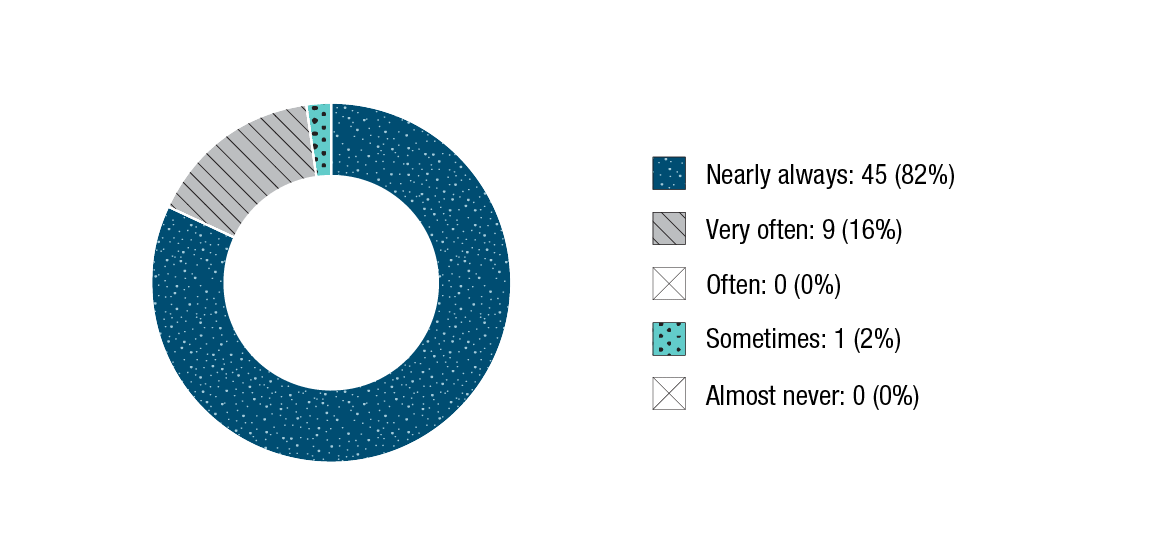
Figure 2 - Text version
| Nearly always | Very often | Often | Sometimes | Almost never | |
|---|---|---|---|---|---|
| Amount | 45 | 9 | 0 | 1 | 0 |
| Percentage (%) | 82% | 16% | 0% | 2% | 0% |
Signs identifying the institution’s offices or facilities
Federal institutions put in place various measures to ensure the active offer of communications with and services to the public in both official languages in bilingual offices. The Policy on Official Languages defines active offer as follows: “Clearly indicate visually and verbally that members of the public can communicate with and obtain services from a designated office in either English or French.” Ninety-three percent of all institutions stated that the signs identifying their offices are nearly always in both official languages. This is the case for 89% of small institutions that submitted a review.
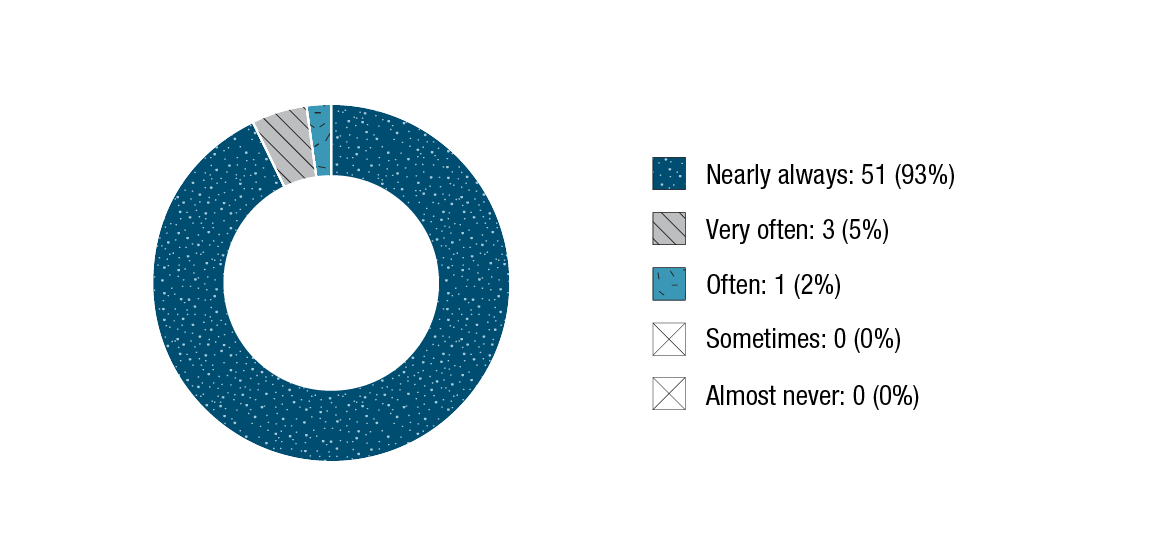
Figure 3 - Text version
| Nearly always | Very often | Often | Sometimes | Almost never | |
|---|---|---|---|---|---|
| Amount | 51 | 3 | 1 | 0 | 0 |
| Percentage (%) | 93% | 5% | 2% | 0% | 0% |
Small institutions’ websites
Eighty-nine percent of small institutions indicated that the English and French versions of their websites are nearly always simultaneously posted in full and are of equal quality; the remaining 11% indicated that this is very often the case.
Greeting the public in person
A smaller percentage of all institutions indicated that they take appropriate measures to greet the public in person in both official languages. It is nearly always the case for 79% of them (89% for small institutions), and it is very often the case for 11% of them (4% of small institutions).
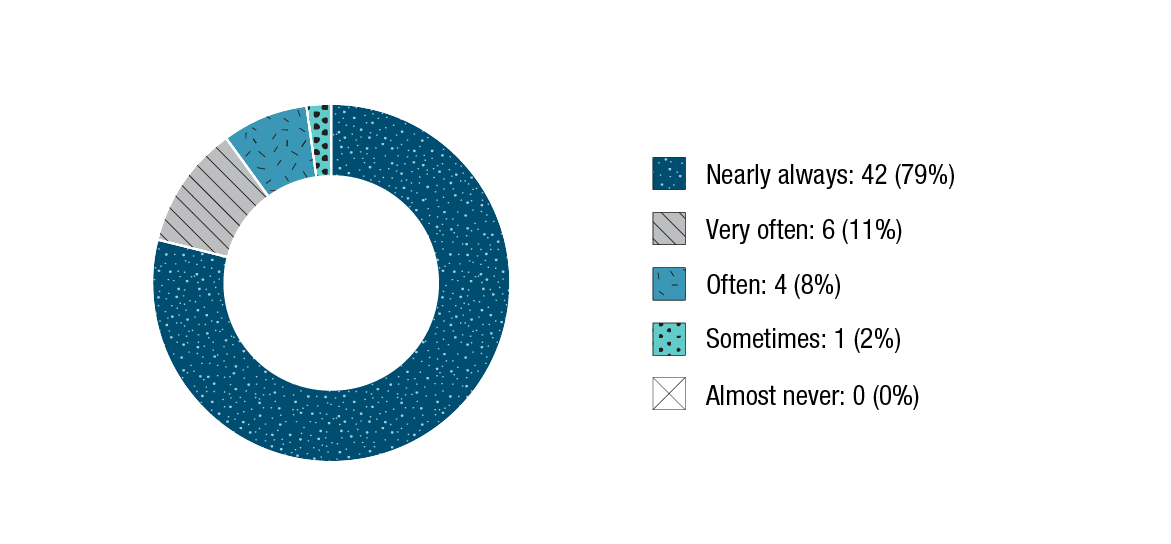
Figure 4 - Text version
| Nearly always | Very often | Often | Sometimes | Almost never | |
|---|---|---|---|---|---|
| Amount | 42 | 6 | 4 | 1 | 0 |
| Percentage (%) | 79% | 11% | 8% | 2% | 0% |
Contracts and agreements with third parties
Large and key institutionsFootnote 8 stated that contracts and agreements with third parties acting on behalf of bilingual offices contain clauses setting out these third parties’ language obligations (76%, nearly always; 12%, very often). They also indicated that they ensure that measures are taken to verify that the language clauses are respected (83%, nearly always; 9%, very often). Two institutions (National Defence and Fisheries and Oceans Canada), indicated that the question did not apply to them.Footnote 9
Use of advertising vehicles
All large and key institutions stated that they nearly always (96%) or very often (4%) select and use advertising vehicles so that they can reach their target audience in the most efficient way possible in the official language of their choice.
Review of the Official Languages (Communications with and Services to the Public) Regulations
On , the President of the Treasury Board and the Minister of Canadian Heritage announced that the government would be reviewing the Official Languages (Communications with and Services to the Public) Regulations (the regulations).
The regulations implement important provisions of Part IV of the Official Languages Act, which covers communications with the public and the delivery of services in English and French.
For example, the regulations specify the circumstances under which the nature or mandate of a federal office or institution is such that services must be delivered in both official languages. They also set out the criteria used to determine, using the most recent decennial census, whether the demand for services in both official languages is sufficient for the office to offer bilingual services.
The regulatory review is part of the commitment to ensure that all federal services are delivered in full compliance with the Official Languages Act. The review mainly seeks to:
- develop a new calculation method for estimating demand for services in the minority official language that will reflect the needs and interests of minority language communities, correspond to current demographic realities and be adaptable to future demographic changes
- explore opportunities offered by new technologies to improve service delivery in both official languages
- improve bilingual services in the transportation sector, including in airports
- adjust certain provisions of the regulations to reflect, among other things, government restructuring and new means of service delivery
As part of this review, the government is committed to consulting parliamentarians, interested parties and the public, including members of official language minority communities. The announcement of the regulatory review was well received by key stakeholders and the Fédération des communautés francophones et acadienne du Canada, the Quebec Community Groups Network, as well as parliamentary sponsors of Bill S-209, An Act to amend the Official Languages Act (Communications with and Services to the Public).
Maintenance of services in both official languages during the regulatory review
When the review was announced, the government imposed a moratorium on changes to services in offices that were in the process of becoming unilingual as part of the regulations reapplication exercise and that were still in that process at the time of the announcement, so that they would continue to provide services to the public in both official languages until new, better-adapted regulations were in place.
To ensure compliance with the regulations, the President of the Treasury Board approved an amendment to the Directive on the Implementation of the Official Languages (Communications with and Services to the Public) Regulations. This amendment, which took effect on , enabled the 250 federal offices and Air Canada routes still participating in this process to continue offering services to the public in both official languages. The list of the 250 offices affected by this amendment to the directive is posted on Burolis, the official inventory of federal offices and their language obligations.
According to the directive, the language obligations of offices subject to the rules of significant demand in the regulations must be reviewed following the release of the most recent decennial census. A regulations reapplication exercise was therefore initiated in , when Statistics Canada published the population data on the first-official-language-spoken variable.
To support this process and to facilitate the implementation of possible regulatory changes, it was preferable that certain offices adopt administrative measures to maintain their capacity to communicate with the public and provide services in both official languages during the review.
For these reasons, in accordance with the powers vested in the Treasury Board of Canada under paragraph 46(2)(a) of the Official Languages Act and in accordance with the delegation of the authority to amend the directive given to the President of the Treasury Board, the President added paragraph 6.2.3 to the directive, which reads as follows:
Deputy heads or their delegates are responsible for ensuring the following:
…
6.2.3 Despite subsections 6.2.1 and 6.2.2 of this directive, and in order to facilitate a regulatory review, take administrative measures to ensure that offices that are no longer required to communicate with and provide services to the public in both official languages following the publication of the Population Estimates by First Official Language Spoken of the most recent decennial census continue to communicate with and provide services to the public in both official languages until the first of the following two dates: (1) the coming into force of new regulatory measures, if any, following a regulatory review, or (2) such time as deputy heads or their delegates review and update the language obligations of offices subject to the provisions of the Regulations, pursuant to subsection 6.2.1 of this directive and to section 3 of the Regulations, following the publication of the Population Estimates by First Official Language Spoken of the next decennial census in 2021.
This amendment was adopted in response to concerns from interested parties about the reduction in the number of bilingual offices between now and the time the new regulations are adopted.
As of , all 20 institutions that had offices affected by the moratorium indicated that they had taken necessary administrative measures to ensure that offices subject to the new subsection 6.2.3 of the directive continue to communicate with and provide services to the public in both official languages.
Status of the regulatory review
In the fall of 2016, OCHRO established internal and external working groups with key stakeholders, including federal institutions, the Fédération des communautés francophones et acadienne du Canada, the Quebec Community Groups Network and the Office of the Commissioner of Official Languages.
As part of the regulatory review, OCHRO is working with Statistics Canada to develop a new calculation method for estimating the potential demand for services in the minority language. The Experts Advisory Group was also created to directly advise the President of the Treasury Board on the regulatory review. The regulatory review process is expected to conclude with the adoption of new regulations in 2019.
The regulations reapplication exercise, which consisted of reviewing the language obligations of offices that are subject to the regulations using data from the 2011 decennial census, was completed as scheduled in . The Burolis website was updated using the results from the regulations reapplication exercise in
Language of work
Bilingual meetings
In regions designated bilingual for language of work purposes, 82% of all the institutions reporting in fiscal year 2016 to 2017 stated that meetings are nearly always (45%) or very often (37%) conducted in both official languages and that employees may use the official language of their choice. However, among small institutions, 68% indicated that this is nearly always the case, and 18% stated that this is very often the case. Eight institutions do not have offices in bilingual regions, and six indicated that the question did not apply to them.
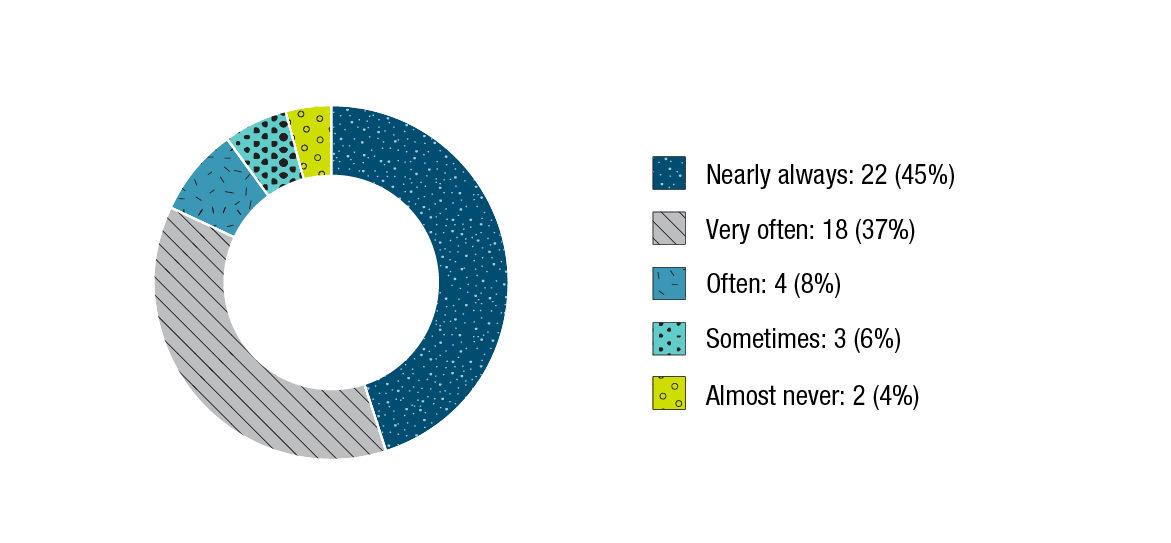
Figure 5 - Text version
| Nearly always | Very often | Often | Sometimes | Almost never | |
|---|---|---|---|---|---|
| Amount | 22 | 18 | 4 | 3 | 2 |
| Percentage (%) | 45% | 37% | 8% | 6% | 4% |
Bilingual supervision
Seventy-one percent of institutions stated that incumbents of bilingual or either/or positionsFootnote 10 are nearly always supervised in the official language of their choice, regardless of whether the supervisors are located in bilingual or unilingual regions; 23% reported that this is very often the case. For small institutions, this is nearly always the case for 81% and very often the case for 19%. Eight institutions do not have offices in bilingual regions, and seven indicated that the question did not apply to them.
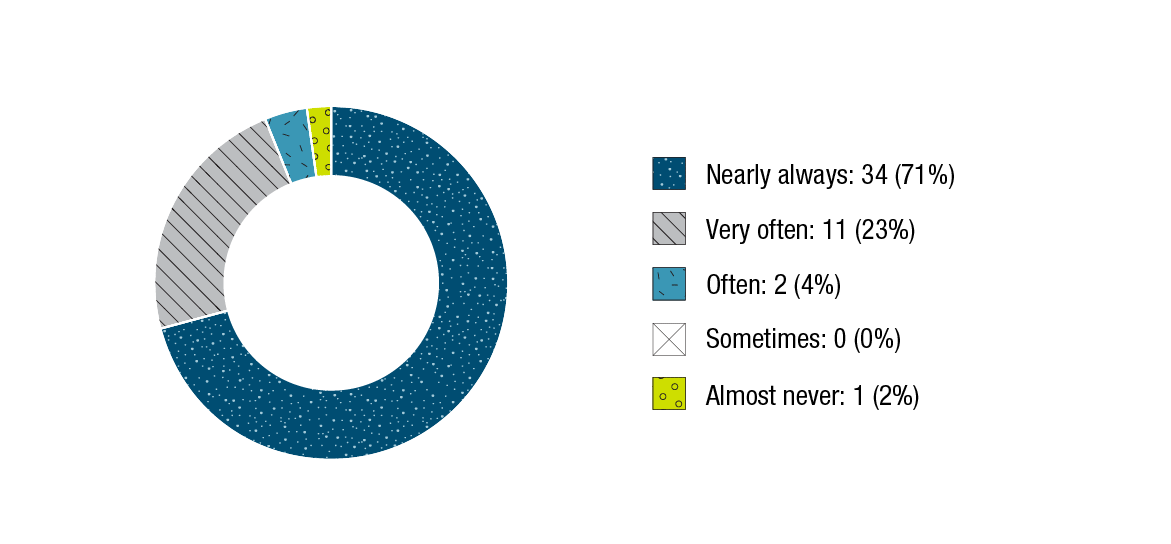
Figure 6 - Text version
| Nearly always | Very often | Often | Sometimes | Almost never | |
|---|---|---|---|---|---|
| Amount | 34 | 11 | 2 | 0 | 1 |
| Percentage (%) | 71% | 23% | 4% | 0% | 2% |
Personal and central services
Almost all institutions that submitted a review stated that personal and central services are nearly always (85%) or very often (15%) provided to employees in bilingual regions in the official language of their choice. For small institutions, 95% of them indicated that this is nearly always the case. Eight institutions indicated that the question did not apply to them.
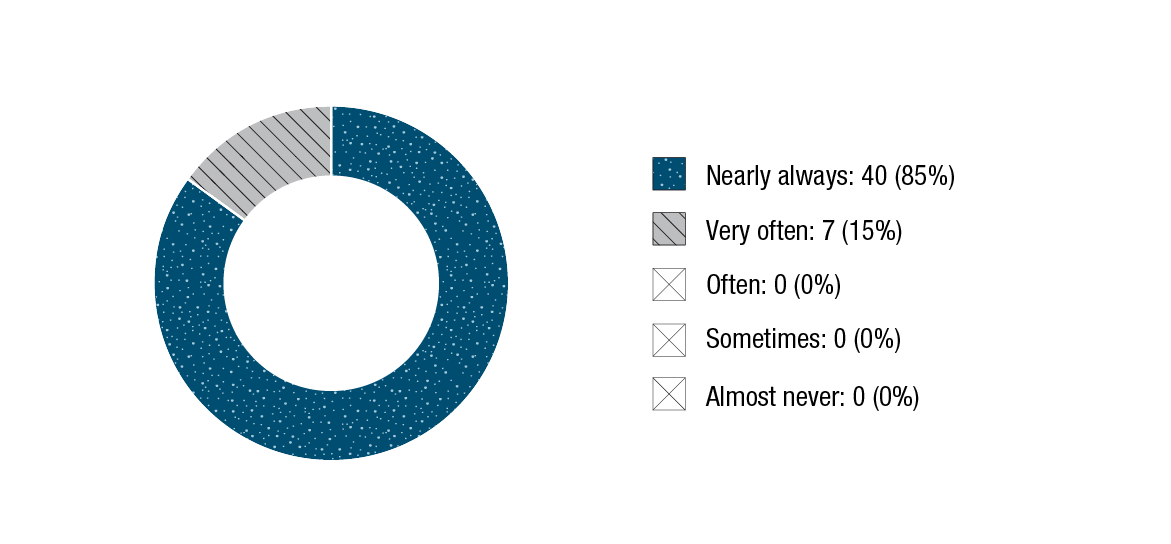
Figure 7 - Text version
| Nearly always | Very often | Often | Sometimes | Almost never | |
|---|---|---|---|---|---|
| Amount | 40 | 7 | 0 | 0 | 0 |
| Percentage (%) | 85% | 15% | 0% | 0% | 0% |
Training and professional development
Large and key institutionsFootnote 11 reported that employees nearly always (78%) or very often (15%) obtain training or professional development in the official language of their choice.
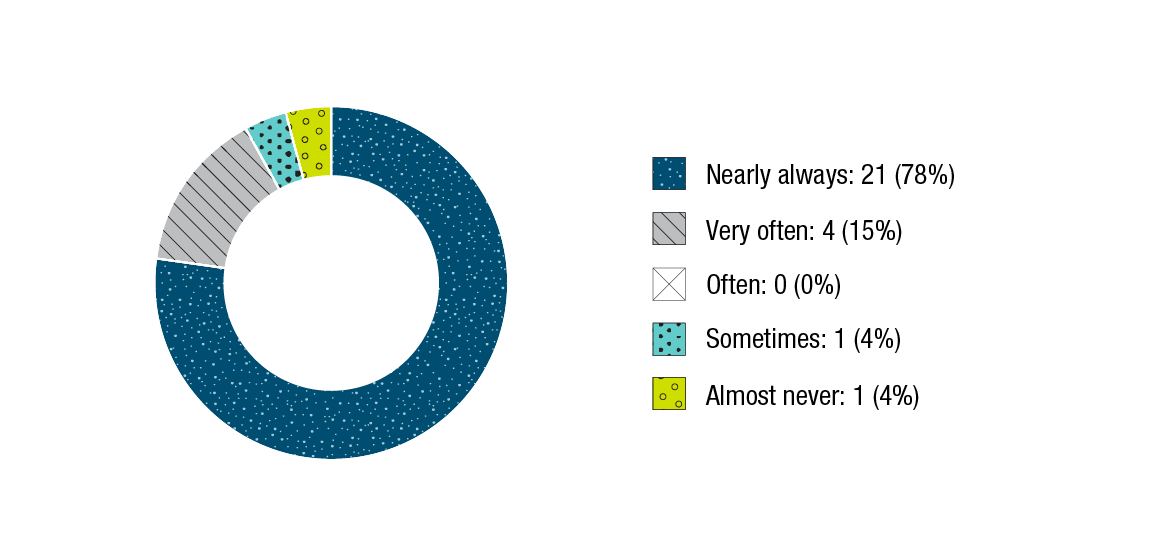
Figure 8 - Text version
| Nearly always | Very often | Often | Sometimes | Almost never | |
|---|---|---|---|---|---|
| Amount | 21 | 4 | 0 | 1 | 1 |
| Percentage (%) | 78% | 15% | 0% | 4% | 4% |
Documentation and work instruments
In the majority of large and key institutions, documentation and regularly and widely used work instruments and electronic systems are nearly always (85%) or very often (11%) available to employees in the official language of their choice.
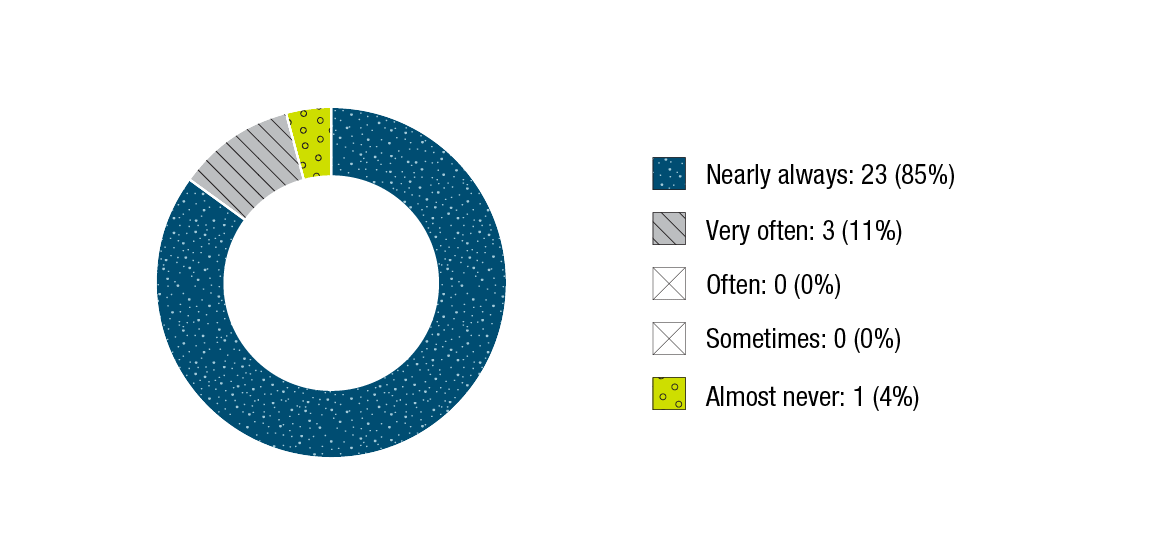
Figure 9 - Text version
| Nearly always | Very often | Often | Sometimes | Almost never | |
|---|---|---|---|---|---|
| Amount | 23 | 3 | 0 | 0 | 1 |
| Percentage (%) | 85% | 11% | 0% | 0% | 4% |
Drafting documents
Among large and key institutions, 56% stated that employees can nearly always draft documents in the official language of their choice; 37% of them stated that they can do so very often.

Figure 10 - Text version
| Nearly always | Very often | Often | Sometimes | Almost never | |
|---|---|---|---|---|---|
| Amount | 15 | 10 | 1 | 0 | 1 |
| Percentage (%) | 56% | 37% | 4% | 0% | 4% |
Work instruments in unilingual regions
In unilingual regions, 96% of large and key institutions stated that regularly and widely used work instruments are nearly always available in both official languages for employees who provide bilingual services to the public or to employees in a bilingual region. For 4% of these institutions, this is often the case. The Treasury Board of Canada Secretariat indicated that this question did not apply to it since it has offices in the National Capital Region only.Footnote 14

Figure 11 - Text version
| Nearly always | Very often | Often | Sometimes | Almost never | |
|---|---|---|---|---|---|
| Amount | 25 | 1 | 0 | 0 | 0 |
| Percentage (%) | 96% | 4% | 0% | 0% | 0% |
Human resources management (including equitable participation)
Part VI of the Official Languages Act provides that workforce participation rates of Anglophones and Francophones in the federal public service should generally align with their representation in the Canadian population.
On , the participation rate of Anglophones in all federal institutions subject to the act was 73.7%. The participation rate of Francophones was 26.3%. In the core public administration, the participation rate was 69.0% for Anglophones and 31.0% for Francophones.
According to data from the 2016 Census, 75.4% of the Canadian population have English as their first official language and 22.8%, French. Based on a comparison of the workforce data and the most recent data from the 2016 Census, employees from both official language communities continue to be well represented in all federal institutions subject to the act. The participation rates of the two linguistic groups have remained relatively stable over the past six years.
Administrative measures to perform bilingual functions
Institutions that submitted a review for fiscal year 2016 to 2017 stated that administrative measures are nearly always (92%) or very often (8%) taken to ensure that bilingual positions are staffed appropriately so that services to the public and to employees can be offered in the official language of their choice, when required by Treasury Board policies. This was nearly always the case for all small institutions (100%). For two other institutions, the Pacific Pilotage Authority and the Windsor Port Authority, the question did not apply.Footnote 15
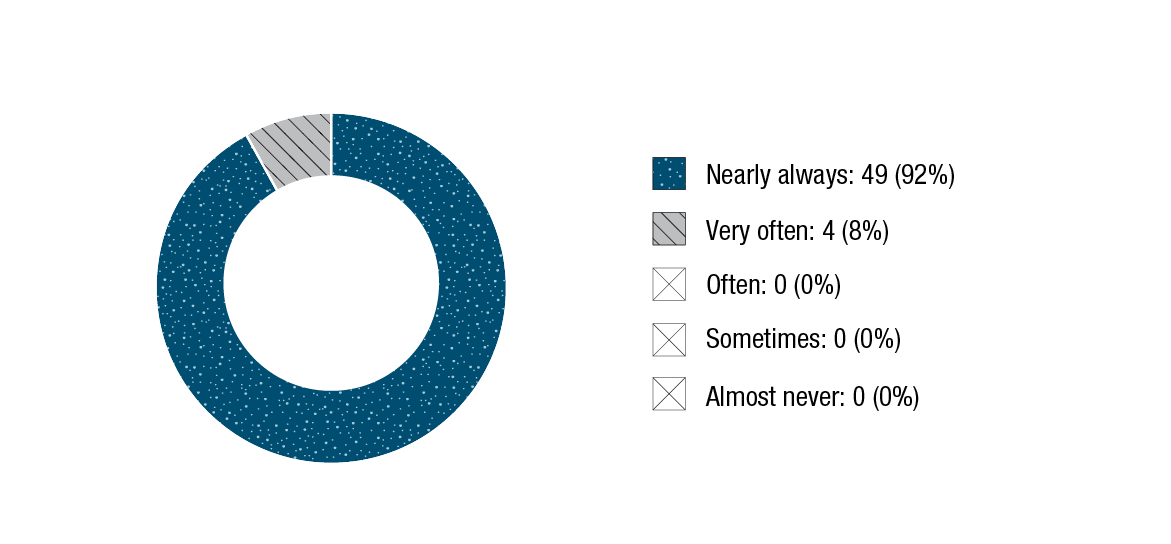
Figure 12 - Text version
| Nearly always | Very often | Often | Sometimes | Almost never | |
|---|---|---|---|---|---|
| Amount | 49 | 4 | 0 | 0 | 0 |
| Percentage (%) | 92% | 8% | 0% | 0% | 0% |
Establishing language requirements of bilingual positions
Almost all of the institutions stated that the language requirements of bilingual positions are nearly always (82%) or very often (18%) established objectively. Linguistic profiles reflect the duties of employees or their work units and take into account the obligations related to service to the public and language of work. Small institutions reported that for 92% of them, this is nearly always the case; for 8% of them, it is very often the case. Four small institutions indicated that the question did not apply to them: the Nanaimo Port Authority, the Windsor Port Authority, the Atlantic Pilotage Authority and the Pacific Pilotage Authority.
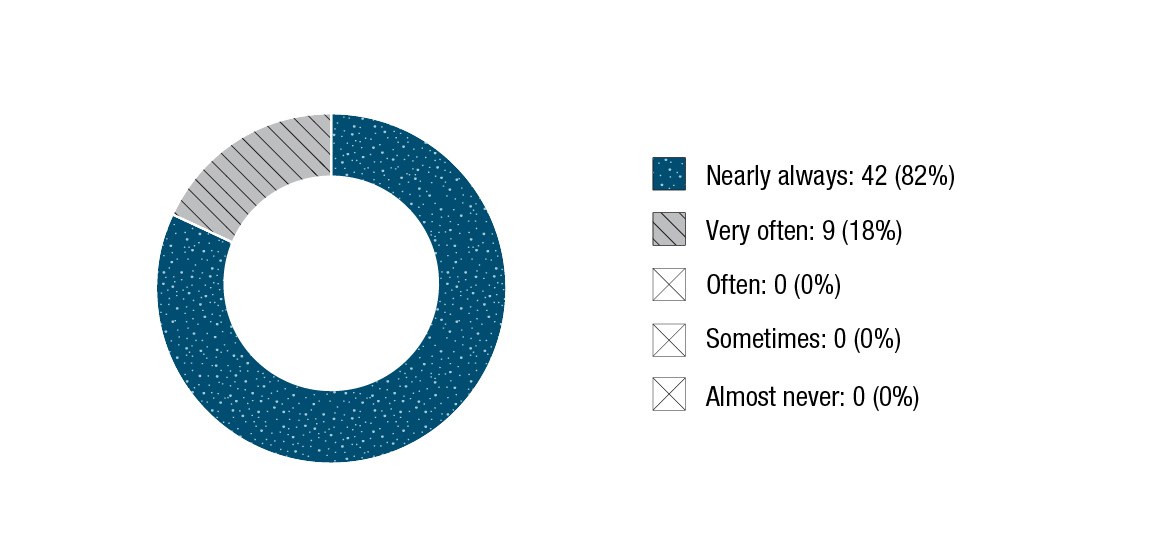
Figure 13 - Text version
| Nearly always | Very often | Often | Sometimes | Almost never | |
|---|---|---|---|---|---|
| Amount | 42 | 9 | 0 | 0 | 0 |
| Percentage (%) | 82% | 18% | 0% | 0% | 0% |
Staffing bilingual positions
In all institutions where there are bilingual positions, these positions are nearly always (80%) or very often (18%) staffed by candidates who are bilingual upon appointment. This is nearly always the case for 83% of small institutions with bilingual positions and very often the case for 17% of them. The same four institutions as in the previous question indicated that the question did not apply to them.
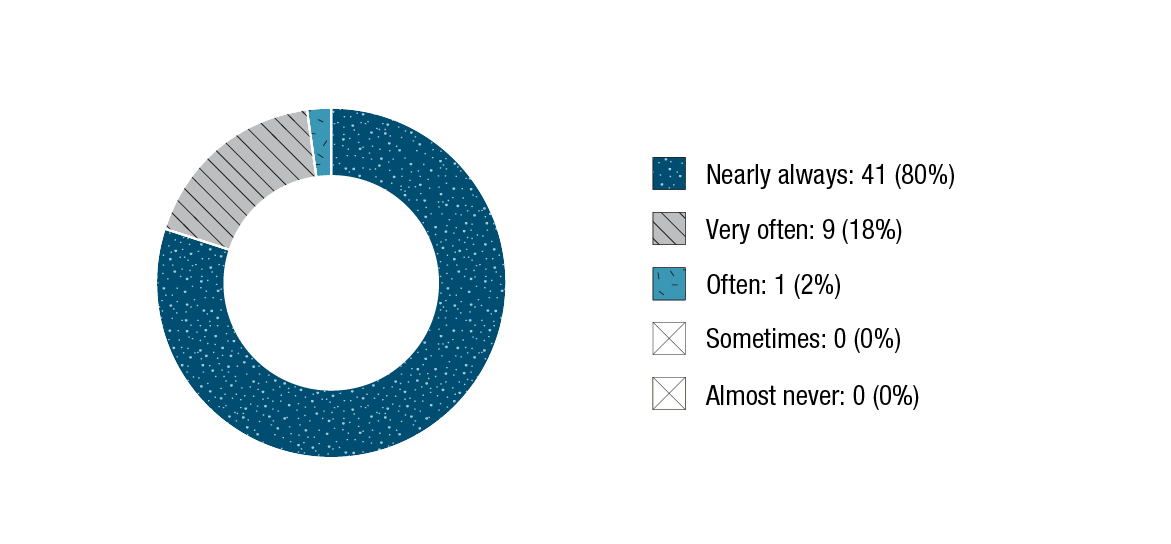
Figure 14 - Text version
| Nearly always | Very often | Often | Sometimes | Almost never | |
|---|---|---|---|---|---|
| Amount | 41 | 9 | 1 | 0 | 0 |
| Percentage (%) | 80% | 18% | 2% | 0% | 0% |
Resources to meet language obligations
The 27 large and key institutions that submitted reviews stated that they nearly always (74%) or very often (19%) have the resources they need to meet their language obligations relating to service to the public and language of work.
To meet these obligations:
- 37% of these 27 institutions almost always provide language training for the career advancement of their personnel, and 41% of them very often do so
- 46% of them nearly always provide a work environment that allows employees returning from language training to use and improve their second language skills so that they can maintain their skills, and 27% of them very often do so
Governance and monitoring
In fiscal year 2016 to 2017, 52% of institutions that have instituted performance agreements with their employees included performance objectives for implementing the various parts of the act. In the case of small institutions, the proportion is 39%. One institution, Fisheries and Oceans Canada, indicated that this did not apply to it.Footnote 16
For almost all large and key institutions, language obligations regularly (59%) or sometimes (37%) appear as items on senior management committee agendas, as needed.
In large and key institutions, the champion or co-champions and the persons responsible for Parts IV, V, VI and VII of the act meet regularly (96%) or sometimes (4%) to discuss the official languages file.
Of the 27 large and key institutions, 25 have established an official languages committee, a network, or a working group made up of representatives from the different sectors or regional offices that meets regularly (84%) or sometimes (12%) to deal horizontally with questions related to language obligations. One institution, Marine Atlantic Inc., does not have such a committee, and the Administrative Tribunals Support Service of Canada argued that this question does not apply to it because any initiative or issue that has an impact on official languages is discussed by the senior management committee.
Of all the institutions that submitted a review, 50 (91%) stated that they regularly take measures to ensure that employees are well aware of the obligations related to various parts of the act. Of all the small institutions, 82% stated that this was the case for them.
Activities to measure availability and quality of services
Sixty-one percent of all institutions conducted activities during the fiscal year to measure the availability and quality of services offered to the public in both official languages. This was the case in 72% of large and key institutions and in 50% of small institutions.
The following types of activities were conducted: quarterly monitoring of performance indicators on language of service, use of a mystery client to ensure that services were actively offered in both official languages, telephone surveys with clients, audits by a private company, monitoring of the allocation of human resources, random checks, in-person observations, and reviews of the quality and consistency of information on the institution’s website in both official languages.
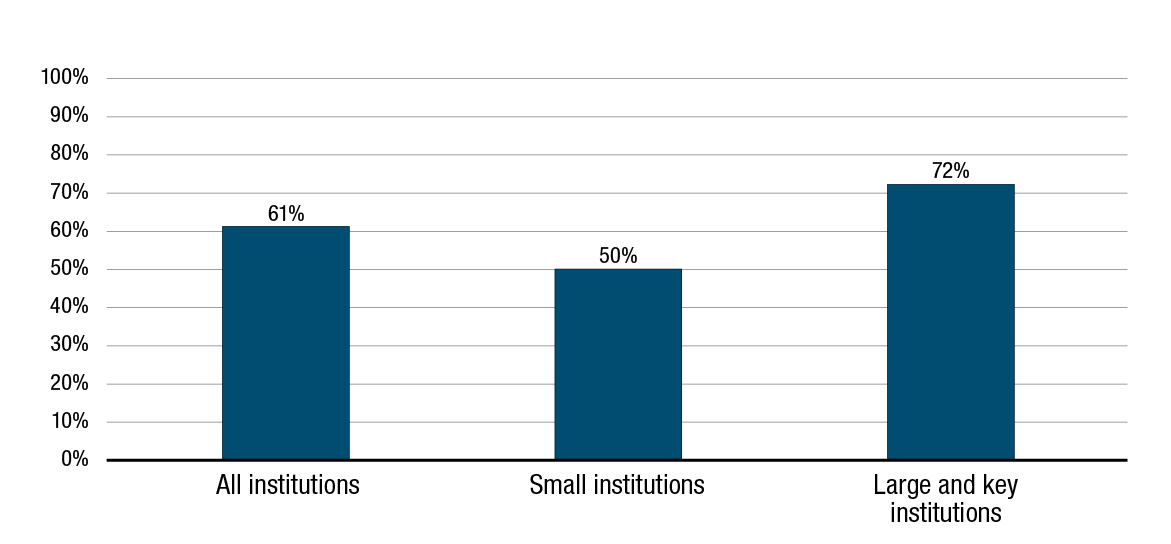
Figure 15 - Text version
| All institutions | Small institutions | Large institutions | |
|---|---|---|---|
| Amount | 31 | 13 | 18 |
| Percentage (%) | 61% | 50% | 72% |
Activities to measure the use of official languages in the workplace
Seventy-eight percent of all institutions, 63% of small institutions, and 88% of large and key institutions carried out activities to periodically measure whether employees in regions designated bilingual for the purposes of language of work can use the official language of their choice in the workplace. Some institutions indicated that they used the results of the 2014 Public Service Employee Survey in their reviews for fiscal year 2016 to 2017 to support their responses regarding language of work.
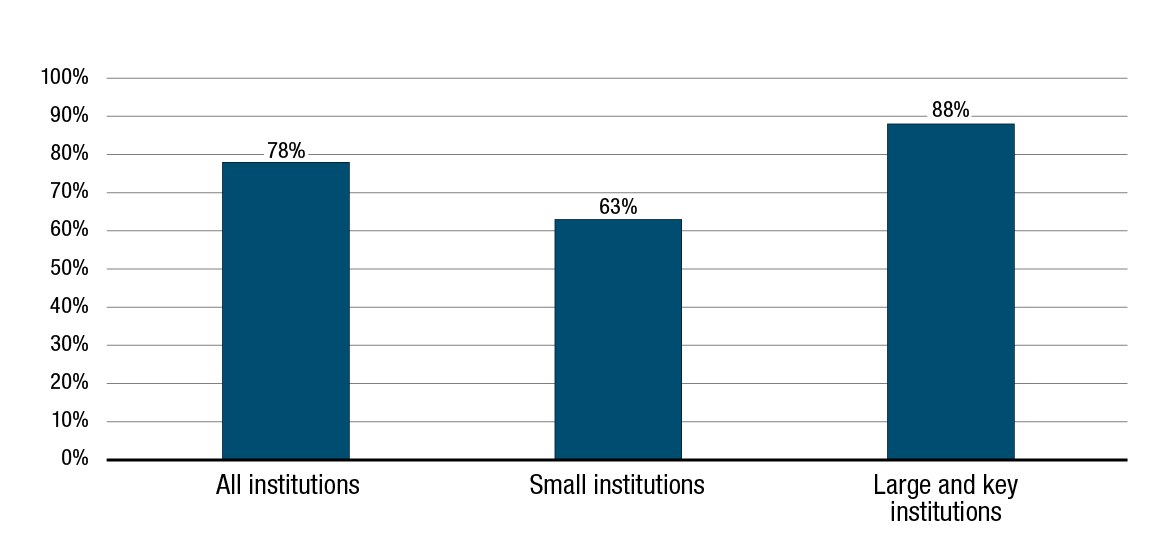
Figure 16 - Text version
| All institutions | Small institutions | Large institutions | |
|---|---|---|---|
| Amount | 35 | 12 | 23 |
| Percentage (%) | 78% | 63% | 88% |
Mechanisms to determine and document impact of decisions
Eighty percent of all institutions, 63% of small institutions, and 96% of large and key institutions indicated that they have mechanisms in place to determine whether their decisions have an impact on the implementation of the act, and to document their findings. Such decisions might have to do with adopting or revising a policy, creating or eliminating a program, or establishing or closing an office. Of the 55 institutions that submitted a review, 10 (including 9 small institutions) stated that they do not have such mechanisms, and 4 small institutions indicated that this question did not apply to them.
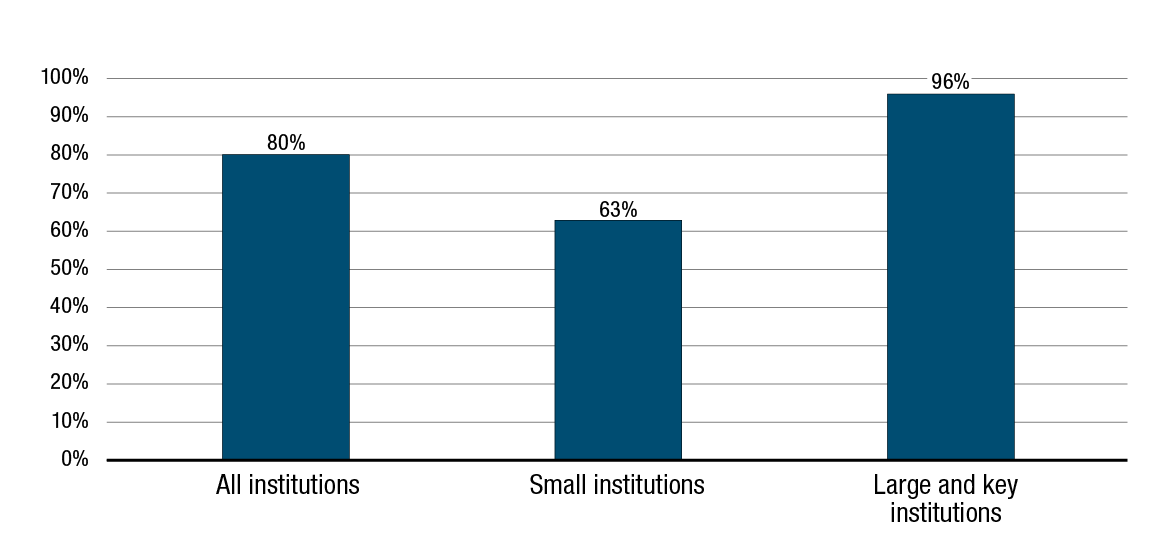
Figure 17 - Text version
| All institutions | Small institutions | Large institutions | |
|---|---|---|---|
| Amount | 41 | 15 | 26 |
| Percentage (%) | 80% | 63% | 96% |
Audit or evaluation activities
Sixty-four percent of institutions stated that audit or evaluation activities are undertaken by their internal audit or other units to evaluate to what extent official language requirements are being implemented. Among small institutions, 50% said that this was the case, and two of them indicated that this does not apply to them, namely, the Nanaimo Port Authority and the Office of the Commissioner of Lobbying of Canada.
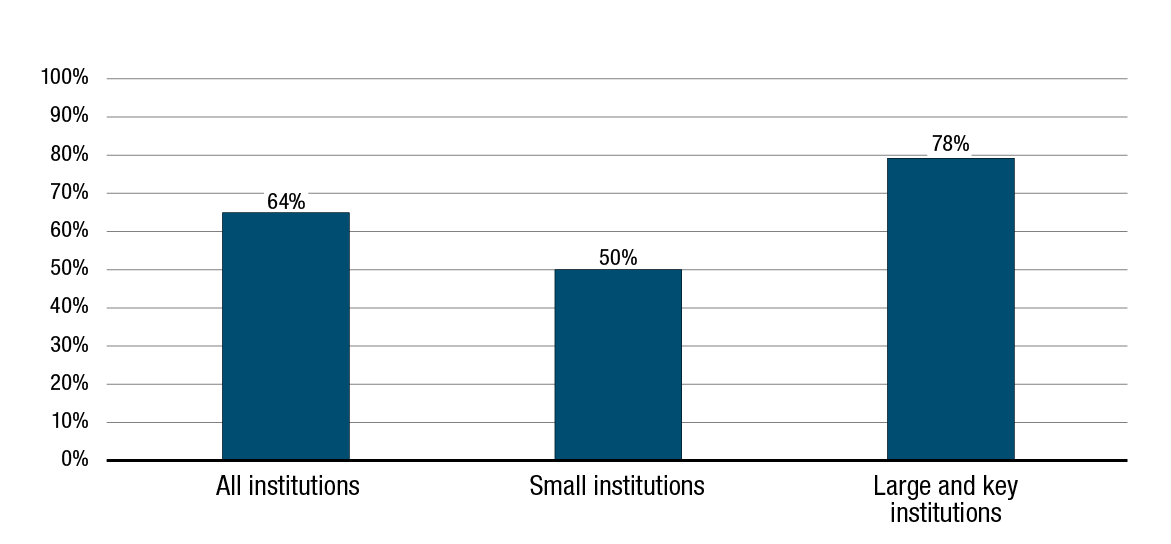
Figure 18 - Text version
| All institutions | Small institutions | Large institutions | |
|---|---|---|---|
| Amount | 34 | 13 | 21 |
| Percentage (%) | 64% | 50% | 78% |
Shortcomings or deficiencies
When monitoring activities or mechanisms reveal shortcomings or deficiencies, almost all of the institutions (94%) stated that steps are taken and documented to improve or rectify the situation in a timely manner. This is the case for 88% of small institutions.
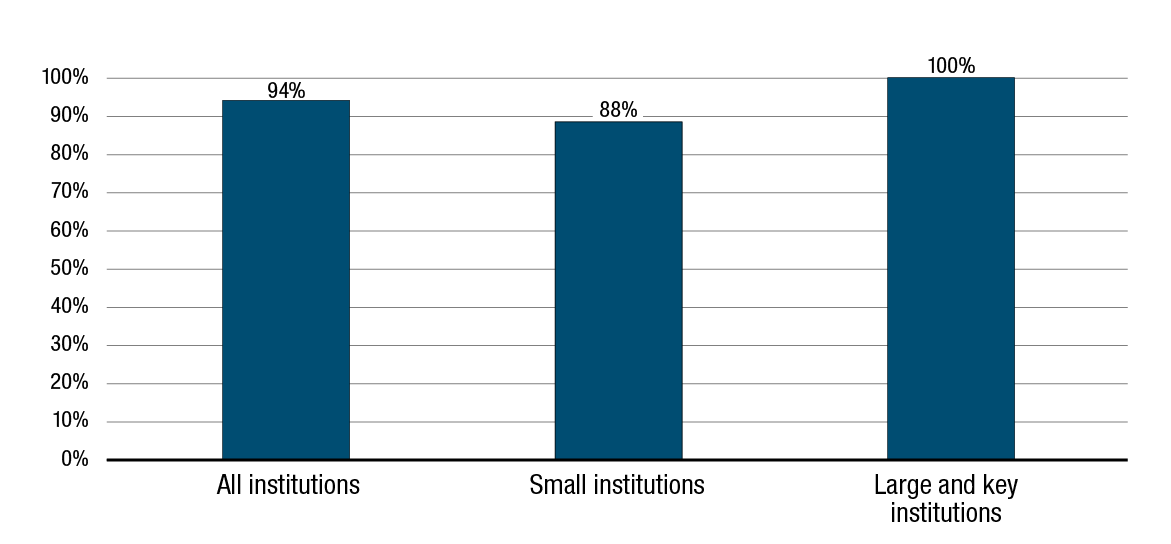
Figure 19 - Text version
| All institutions | Small institutions | Large institutions | |
|---|---|---|---|
| Amount | 34 | 13 | 21 |
| Percentage (%) | 94% | 88% | 100% |
Informing the deputy head
Of all institutions, 92% stated that their deputy head is informed of the results of monitoring activities. The rate is 88% for small institutions.
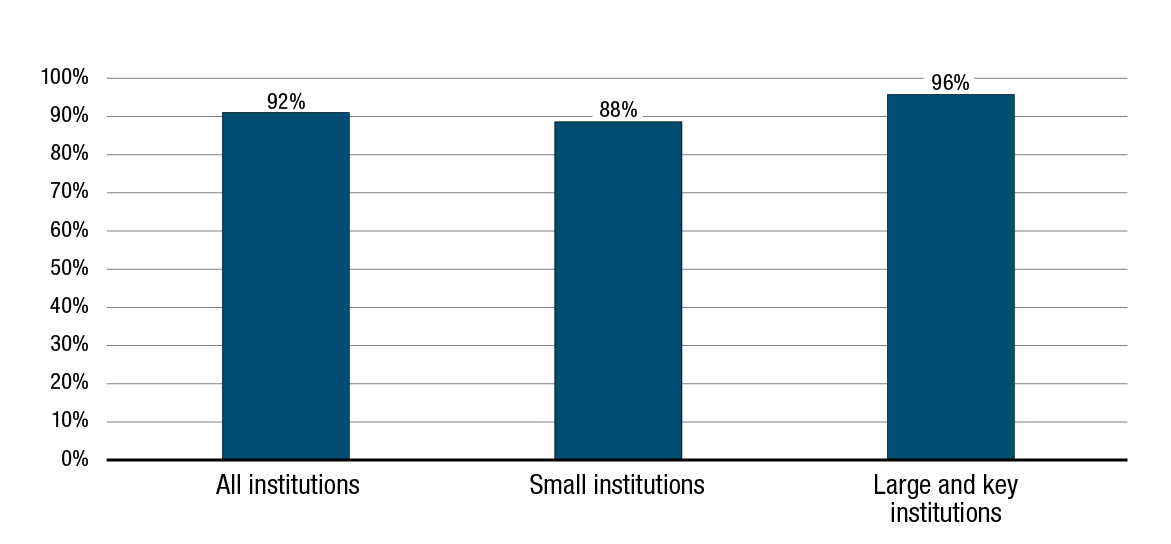
Figure 20 - Text version
| All institutions | Small institutions | Large institutions | |
|---|---|---|---|
| Amount | 46 | 21 | 25 |
| Percentage (%) | 92% | 88% | 96% |
Office of the Chief Human Resources Officer activities and follow-up
In fiscal year 2016 to 2017, OCHRO continued to provide horizontal support to federal institutions on key issues. To help institutions improve their outcomes in certain areas, OCHRO undertook the following activities:
- managed Clearspace, an online platform for sharing information and advice among members of the official languages functional community
- convened the departmental and Crown corporation advisory committees on official languages for workshops, case studies, and discussions
- supported the Council of the Network of Official Languages Champions by contributing to the organization of its annual conference, attending the Council’s regular meetings, and hosting a good practices forum
- participated in meetings of the Committee of Assistant Deputy Ministers on Official Languages and the Directors General Forum, chaired by Canadian Heritage
The Official Languages Centre of Excellence continues to be solicited for advice and interpretation of official languages requirements. Among the 160 requests received last year, key issues were the identification of the language requirements of positions in various staffing situations, the bilingualism bonus, official languages performance objectives, bilingualism in institutional emails and websites, as well as reference tools for addressing official languages requirements when drafting memorandums to Cabinet or Treasury Board submissions.
Along with Canadian Heritage, OCHRO participated in the Conference of Official Languages Champions on , an activity that drew 99 participants from across government. On , an information session was held in Ottawa for approximately 30 newly appointed official languages champions.
Table 2 shows activities led by OCHRO in fiscal year 2016 to 2017.
| Activities | Location and date | Participation |
|---|---|---|
| Conference of official languages champions, with the participation of Canadian Heritage | Gatineau, | 99 participants |
| Discussion on section 91 of the Official Languages Act in relation to staffing | Teleconference, | 40 participants |
| Departmental Advisory Committee on Official Languages | Gatineau, | 95 participants for 2 meetings |
| Information session for new official languages champions | Ottawa, | Approximately 30 participants |
| Official Languages Good Practices Forum, under the auspices of the Council of the Network of Official Languages Champions | Ottawa, | 186 participants |
| Official languages obligations of airport authorities | Teleconference, | Approximately 15 airport authorities represented |
| Departmental Advisory Committee on Official Languages | Ottawa, | 95 participants for 2 meetings |
| Crown Corporations Advisory Committee on Official Languages | Ottawa, | 35 participants |
OCHRO continues to play a leadership role by supporting the Official Languages Good Practices Forum. The forum drew 186 participants from various federal institutions, who met in Ottawa to share good practices relating to official languages. The format chosen for the forum consisted of short Dragon’s Den-style promotional pitches about good practices that have been successful in some institutions with a view to others adopting them. Certain resources developed by OCHRO can be found in the 2017 Collection of Official Languages Resources, published by the Council of the Network of Official Languages Champions.
Language of work project
In the fall of 2016, the Clerk of the Privy Council asked Patrick Borbey, then Associate Deputy Minister of Canadian Heritage, and Matthew Mendelsohn, Deputy Secretary to the Cabinet (Results and Delivery) at the Privy Council Office, to develop a plan to improve the use of official languages in the workplace. The initiative was prompted, in part, by the results of the 2014 Public Service Employee Survey, which had revealed that employees, particularly Francophones, did not feel as comfortable as their Anglophone colleagues to use their language of choice in meetings, when drafting documents and in interactions with their supervisor.
Public servants were consulted about how to make the work environment more conducive to the use of both official languages. OCHRO, through the Official Languages Centre of Excellence, supported the consultations with stakeholders, including human resources specialists, managers, champions for visible minorities, persons with disabilities and Indigenous people, as well as union representatives. Table 3 shows the consultations held in fiscal year 2016 to 2017.
| Consultations | Date | Participation | Key proposals |
|---|---|---|---|
| Departmental Advisory Committee on Official Languages | 48 in person, 5 by teleconference | Focus on leadership, respect and inclusion | |
| Visible Minorities Champions and Chairs Committee | 16 in person, 36 by teleconference | Give priority to visible minorities for language training | |
| Persons with Disabilities Champions and Chairs Committee | 6 in person, 16 by teleconference, 2 by videoconference | Consider exemptions for persons with disabilities Allow non-imperative appointments on medical grounds |
|
| Chairs and Champions Circle for Aboriginal People | 15 in person, 22 by teleconference, 1 by videoconference | Promote Aboriginal languages, given the need to provide services to Indigenous communities Allow non-imperative staffing for bilingual positions and provide language training upon hiring |
|
| Human Resources Council | 25 in person, 22 by videoconference | Focus on leadership and accountability to change the culture | |
| Official Languages Champions | Approximately 20 | Reward desired behaviours Encourage Canadian colleges and universities to adapt their programs to foster bilingualism |
|
| National Managers’ Community | 31 in person, 15 by teleconference | Improve the use of good practices in bilingual meetings | |
| National Joint Council | 5 in person, 2 by teleconference | Increase funding for language training |
The report to the Clerk, titled The Next Level: Normalizing a Culture of Inclusive Linguistic Duality in the Federal Public Service Workplace, was released in . It includes a series of recommendations in five key areas: policy, culture, leadership, training and tools. Through its participation as one of the co-chairs on the Committee of Assistant Deputy Ministers on Official Languages, OCHRO will contribute to the follow-up on the report.
Parliamentary appearances
The President of the Treasury Board appeared before the House of Commons Standing Committee on Official Languages, and then before the Standing Senate Committee on Official Languages on , to respond to questions about his annual report to Parliament on official languages. The topics discussed included the President’s mandate, his authority and reporting requirements, official languages governance, the modernization of the Official Languages Regulations, and the use of technology to offer federal services to Canadians in both languages in an innovative manner.
OCHRO officials appeared before the House of Commons Standing Committee on Official Languages on , along with their counterparts from Canadian Heritage. The discussion focussed on the legislative responsibilities of the Treasury Board and the Treasury Board of Canada Secretariat, the Policy on Official Languages, the data sources for the annual report, the reviews on official languages received from federal institutions, as well as the reporting requirements in relation to official languages for departmental performance reports.
OCHRO representatives appeared once more before the House of Commons Standing Committee on Official Languages on , to answer questions about the Centre of Excellence’s role in policy, monitoring, and support to institutions subject to the act.
Conclusion and trends
Linguistic duality is a core value for Canada and for the public service. The capacity to use both official languages is essential to providing services to Canadians in the official language of their choice. That is why bilingualism remains a key government priority. The review of the Official Languages (Communications with and Services to the Public) Regulations, which was launched in , is an opportunity to update the provisions that govern the circumstances under which federal services must be made available in either or both official languages.
Consultations with key stakeholders have enriched the government’s thinking on the best possible approach to service delivery in a connected, inclusive, diverse and bilingual society. Work on the modernization of the Official Languages Regulations is ongoing. Parliamentarians and citizens are invited to comment on proposed regulations to help ensure that they are adapted to the needs of all Canadians, support the vibrancy of both of our official languages and enhance the vitality of official language minority communities across the country.
To have the capacity to provide quality services externally, the public service must remain vigilant internally. The use of English and French enriches the public service work environment. Managers and supervisors, in particular, have a role to play in promoting bilingualism and in fostering a workplace that is conducive to the use of both official languages in designated bilingual regions.
The report The Next Level: Normalizing a Culture of Inclusive Linguistic Duality in the Federal Public Service Workplace, which was presented to the Clerk of the Privy Council in , is a reminder of the efforts that still need to be made to create an exemplary bilingual work environment. The Government of Canada is determined to build on the momentum created by the release of this report. OCHRO, in collaboration with its partners at Canadian Heritage, the Department of Justice Canada and the Privy Council Office, is taking concrete steps toward implementing the report’s recommendations in order to promote both official languages as part of a respectful, inclusive and diverse workplace.
Evidence-based accountability is a critical component of taking action. An analysis of the results of the 2017 Public Service Employee Survey will provide fresh insight into public servants’ perceptions of the use of official languages in the workplace. In order for more effective actions to be taken, the governance of official languages has been strengthened. The mandate of the Committee of Assistant Deputy Ministers on Official Languages, which is co-chaired by OCHRO, has been revised: the committee will now provide high-level advice and guidance across the entire official languages program. OCHRO will continue its collaboration with and support to key partners, including official languages champions and persons responsible for official languages in departments, Crown corporations and agencies.
Looking ahead, 2018 marks the beginning of a new chapter with the launch of the Action Plan for Official Languages (2018 to 2023) by the Minister of Canadian Heritage. The action plan is an opportunity for a comprehensive renewal of Canada’s commitment to official languages. OCHRO’s work on modernizing the Official Languages Regulations is designed to improve access to services in both official languages in a way that is sensitive to and supportive of the vitality of official language minority communities. At the same time, creating a work environment that encourages the use of both official languages every day strengthens an inclusive, creative and high-performing public service dedicated to serving Canadians. Our linguistic duality thrives on the enthusiasm and countless initiatives in the public service and beyond. It is the government’s firm commitment to maintain and strengthen the conditions that will allow both official languages to flourish.
Appendix A: Federal institutions required to submit a review for fiscal year 2016 to 2017
Fifty-five federal institutions submitted a review for fiscal year 2016 to 2017. The distinction between small institutions and large and key institutions was based on size and mandate in relation to official languages. Large and key institutions were required to respond to a longer questionnaire. In general, small institutions are those with fewer than 500 employees.
-
In this section
Large and key institutions
- Administrative Tribunals Support Service of Canada
- Air Canada
- Canada Border Services Agency
- Canada Post
- Canada Revenue Agency
- Canadian Broadcasting Corporation
- Canadian Forces Morale and Welfare Services
- Canadian Heritage
- Canadian National Railway Company
- Communications Security Establishment Canada
- Correctional Service Canada
- Employment and Social Development Canada
- Fisheries and Oceans Canada
- Global Affairs Canada
- Health Canada
- Immigration and Refugee Board of Canada
- Immigration, Refugees and Citizenship Canada
- Innovation, Science and Economic Development Canada
- Marine Atlantic Inc.
- National Defence
- Natural Resources Canada
- Public Services and Procurement Canada
- Royal Canadian Mounted Police
- Shared Services Canada
- Transport Canada
- Treasury Board of Canada Secretariat
- VIA Rail Canada Inc.
Small institutions
- Atlantic Pilotage Authority
- Canada Science and Technology Museum
- Canadian Commercial Corporation
- Canadian Dairy Commission
- Canadian Institutes of Health Research
- Canadian Intergovernmental Conference Secretariat
- Canadian Museum of History
- Canadian Museum of Nature
- Federal Bridge Corporation
- Financial Consumer Agency of Canada
- Indian Oil and Gas Canada
- International Development Research Centre
- The Jacques Cartier and Champlain Bridges Inc.
- Laurentian Pilotage Authority
- Military Police Complaints Commission of Canada
- Nanaimo Port Authority
- The National Battlefields Commission
- Office of the Commissioner of Lobbying of Canada
- Office of the Secretary to the Governor General
- Pacific Pilotage Authority
- Patented Medicine Prices Review Board Canada
- Polar Knowledge Canada
- Québec Port Authority
- Saguenay Port Authority
- Seaway International Bridge Corporation
- Security Intelligence Review Committee
- Standards Council of Canada
- Windsor Port Authority
Appendix B: Definitions
- "Position"
- means a position filled for an indeterminate period or a determinate period of three months or more, according to the information in the Position and Classification Information System (PCIS).
- "Resources"
- refers to the resources required to meet obligations on a regular basis, according to the information available in the Official Languages Information System II (OLIS II). Resources can consist of a combination of full-time and part-time employees, as well as contract resources. Some cases involve automated functions, hence the need to use the term “resources” in this report.
- "Bilingual position"
- is a position in which all or part of the duties must be performed in both English and French.
- "Reversible" or "either/or position"
- is a position in which all the duties can be performed in English or French, depending on the employee's preference.
- "Incomplete record"
- means a position for which data on language requirements is incorrect or missing.
- "Linguistic capacity outside Canada"
- refers to all rotational positions outside Canada (for example, rotational employees) that are staffed from a pool of employees with similar skills. Most of these positions are with Global Affairs Canada.
In statistical tables 5, 7, 10 and 12 in Appendix D, the levels required in second language proficiency refer only to oral interaction (understanding and speaking). The "Other" category refers to positions either requiring code P (specialized proficiency) or not requiring any second language oral interaction skills.
The terms "Anglophone" and "Francophone" refer to employees on the basis of their first official language. The first official language is the language declared by the employee as the one with which he or she has a primary personal identification.
Appendix C: Sources of statistical data
-
In this section
There are three main sources of statistical data in Appendix D:
- Burolis is the official inventory of offices that indicates whether they have an obligation to communicate with the public in both official languages
- The PCIS covers the positions and employees of institutions that are part of the core public administration
- The OLIS II provides information on the resources of institutions that are not part of the core public administration (in other words, Crown corporations and separate agencies)
The reference date for the data in the statistical tables is the same for the data systems (Burolis, the PCIS and OLIS II): .
One institution, Canadian Forces Morale and Welfare Services, was unable to provide complete information on the allocation of their resources by occupational category or on their resources serving the public in English or French for all their designated bilingual offices. The Vancouver International Airport Authority provided no data on this subject.
Notes
Percentages in the tables in Appendix D may not add up to 100% due to rounding.
The data in this report relating to positions in the core public administration are compiled from the Position and Classification Information System.
Pursuant to the Public Service Official Languages Exclusion Approval Order, incumbents may not meet the language requirements of their position for two reasons:
- they are exempt, or
- they have two years to meet the language requirements
The linguistic profile of a bilingual position is based on three levels of second language proficiency:
- Level A: minimum proficiency
- Level B: intermediate proficiency
- Level C: superior proficiency
Appendix D: Statistical tables
Table 1
Bilingual positions and pool of bilingual employees in the core public administration
From fiscal year 2015 to 2016 to fiscal year 2016 to 2017, the percentages of bilingual positions and bilingual employees in the core public administration decreased slightly, by 0.2% and 0.1%, respectively, to 43.0% and 44.8%.
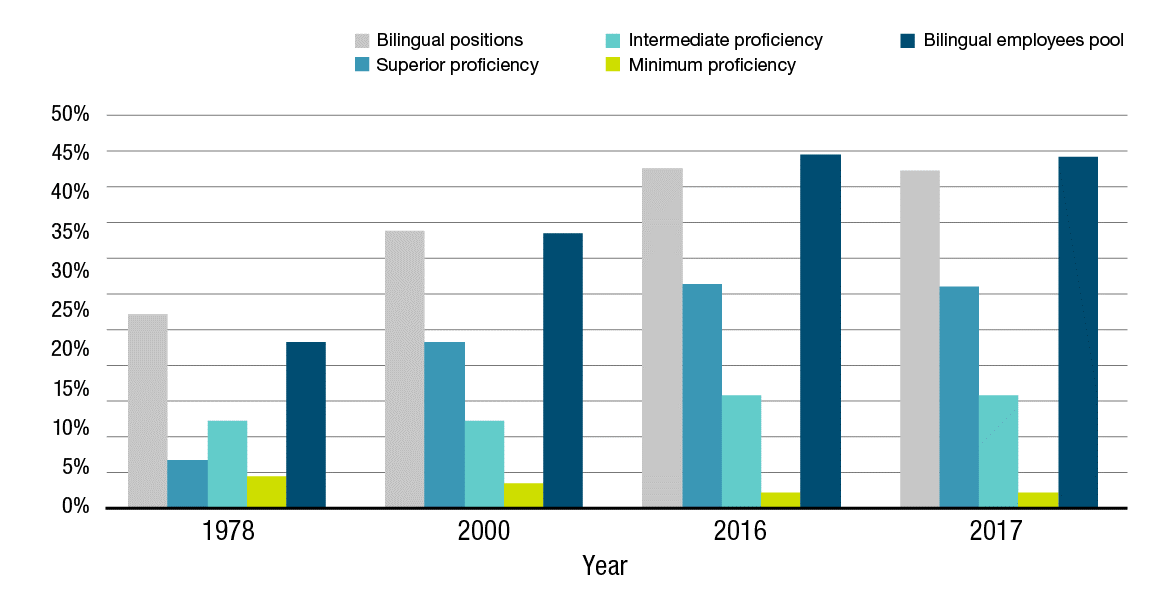
Figure 21 - Text version
| Year | Bilingual positions | Superior proficiency | Intermediate proficiency | Minimum proficiency | Pool of bilingual employees |
|---|---|---|---|---|---|
| 1978 | 25% | 6% | 11% | 4% | 21% |
| 2000 | 35% | 21% | 11% | 3% | 35% |
| 2016 | 43% | 28% | 14% | 2% | 45% |
| 2017 | 43% | 28% | 14% | 2% | 45% |
Table 2
Language requirements of positions in the core public administration
From fiscal year 2015 to 2016 to fiscal year 2016 to 2017, the number and proportion of bilingual positions in the core public administration declined slightly, as did once again the total number of positions.
| Year | Bilingual positions | English essential positions | French essential positions | English or French essential positions | Incomplete records | Total positions | |||||
|---|---|---|---|---|---|---|---|---|---|---|---|
| 1978 | 52,300 | 24.7% | 128,196 | 60.5% | 17,260 | 8.1% | 14,129 | 6.7% | 0 | 0.0% | 211,885 |
| 2000 | 50,535 | 35.3% | 75,552 | 52.8% | 8,355 | 5.8% | 7,132 | 5.0% | 1,478 | 1.0% | 143,052 |
| 2016 | 78,709 | 43.2% | 90,822 | 49.9% | 6,441 | 3.5% | 5,916 | 3.2% | 222 | 0.1% | 182,110 |
| 2017 | 77,889 | 43.0% | 90,838 | 50.1% | 6,443 | 3.6% | 5,888 | 3.3% | 82 | 0.0% | 181,140 |
Table 3
Language requirements of positions in the core public administration, by province, territory or region
Of the 181,140 positions in the core public administration in fiscal year 2016 to 2017, a total of 77,889 positions were bilingual. Most of the bilingual positions were in the National Capital Region (NCR) (67.9%), Quebec (excluding the NCR) (67.0%) and New Brunswick (52.2%).
| Unilingual positions | |||||||||||
|---|---|---|---|---|---|---|---|---|---|---|---|
| Province, territory or region | Bilingual positions | English essential | French essential | English or French essential | Incomplete records | Total positions | |||||
| British Columbia | 482 | 3.0% | 15,409 | 96.7% | 1 | 0.0% | 29 | 0.2% | 8 | 0.1% | 15,929 |
| Alberta | 367 | 3.8% | 9,294 | 96.0% | 0 | 0.0% | 22 | 0.2% | 3 | 0.0% | 9,686 |
| Saskatchewan | 136 | 3.0% | 4,422 | 96.8% | 3 | 0.1% | 6 | 0.1% | 0 | 0.0% | 4,567 |
| Manitoba | 507 | 7.9% | 5,865 | 91.8% | 0 | 0.0% | 13 | 0.2% | 5 | 0.1% | 6,390 |
| Ontario (excluding the NCR) | 2,645 | 11.1% | 20,971 | 88.2% | 12 | 0.1% | 134 | 0.6% | 17 | 0.1% | 23,779 |
| National Capital Region (NCR) | 54,135 | 67.9% | 19,995 | 25.1% | 145 | 0.2% | 5,409 | 6.8% | 34 | 0.0% | 79,718 |
| Quebec (excluding the NCR) | 13,162 | 67.0% | 133 | 0.7% | 6,221 | 31.6% | 139 | 0.7% | 4 | 0.0% | 19,659 |
| New Brunswick | 3,522 | 52.2% | 3,093 | 45.8% | 46 | 0.7% | 86 | 1.3% | 1 | 0.0% | 6,748 |
| Prince Edward Island | 449 | 27.9% | 1,157 | 71.9% | 0 | 0.0% | 3 | 0.2% | 0 | 0.0% | 1,609 |
| Nova Scotia | 929 | 11.8% | 6,856 | 87.4% | 15 | 0.2% | 36 | 0.5% | 8 | 0.1% | 7,844 |
| Newfoundland and Labrador | 89 | 3.1% | 2,761 | 96.6% | 0 | 0.0% | 8 | 0.3% | 0 | 0.0% | 2,858 |
| Yukon | 13 | 4.6% | 266 | 95.0% | 0 | 0.0% | 1 | 0.4% | 0 | 0.0% | 280 |
| Northwest Territories | 12 | 3.0% | 389 | 97.0% | 0 | 0.0% | 0 | 0.0% | 0 | 0.0% | 401 |
| Nunavut | 14 | 6.0% | 218 | 94.0% | 0 | 0.0% | 0 | 0.0% | 0 | 0.0% | 232 |
| Outside Canada | 1,427 | 99.1% | 9 | 0.6% | 0 | 0.0% | 2 | 0.1% | 2 | 0.1% | 1,440 |
| Total | 77,889 | 43.0% | 90,838 | 50.1% | 6,443 | 3.6% | 5,888 | 3.3% | 82 | 0.0% | 181,140 |
Table 4
Bilingual positions in the core public administration and linguistic status of incumbents
The percentage of employees in bilingual positions in the core public administration who meet the language requirements of their position rose slightly by 0.3% from fiscal year 2015 to 2016.
| Employees do not meet requirements | |||||||||
|---|---|---|---|---|---|---|---|---|---|
| Year | Employees meet requirements | Exempted | Must meet | Incomplete records | Total employees | ||||
| 1978 | 36,446 | 69.7% | 14,462 | 27.7% | 1,392 | 2.7% | 0 | 0.0% | 52,300 |
| 2000 | 41,832 | 82.8% | 5,030 | 10.0% | 968 | 1.9% | 2,705 | 5.4% | 50,535 |
| 2016 | 75,200 | 95.5% | 2,780 | 3.5% | 143 | 0.2% | 586 | 0.7% | 78,709 |
| 2017 | 74,610 | 95.8% | 2,604 | 3.3% | 155 | 0.2% | 520 | 0.7% | 77,889 |
Table 5
Bilingual positions in the core public administration and level of second language proficiency required (oral interaction)
The percentage of bilingual positions in the core public administration that require Level C proficiency for oral interaction has increased by 1.0% since fiscal year 2015 to 2016.
| Year | Level C | Level B | Level A | Other | Total positions | ||||
|---|---|---|---|---|---|---|---|---|---|
| 1978 | 3,771 | 7.2% | 30,983 | 59.2% | 13,816 | 26.4% | 3,730 | 7.1% | 52,300 |
| 2000 | 12,836 | 25.4% | 34,677 | 68.6% | 1,085 | 2.1% | 1,937 | 3.8% | 50,535 |
| 2016 | 27,008 | 34.3% | 49,977 | 63.5% | 414 | 0.5% | 1,310 | 1.7% | 78,709 |
| 2017 | 27,457 | 35.3% | 48,794 | 62.7% | 347 | 0.5% | 1,291 | 1.7% | 77,889 |
Table 6
Service to the public: Bilingual positions in the core public administration and linguistic status of incumbents
From fiscal year 2015 to 2016 to fiscal year 2016 to 2017, the percentage of employees in the core public administration who provide services to the public and who meet the language requirements of their position rose slightly, by 0.3%. This increase is an indication that institutions have the necessary capacity to serve the public in both official languages.
| Employees do not meet requirements | |||||||||
|---|---|---|---|---|---|---|---|---|---|
| Year | Employees meet requirements | Exempted | Must meet | Incomplete records | Total employees | ||||
| 1978 | 20,888 | 70.4% | 8,016 | 27.0% | 756 | 2.5% | 0 | 0.0% | 29,660 |
| 2000 | 26,766 | 82.3% | 3,429 | 10.5% | 690 | 2.1% | 1,631 | 5.0% | 32,516 |
| 2016 | 41,382 | 95.7% | 1,457 | 3.4% | 75 | 0.2% | 333 | 0.8% | 43,247 |
| 2017 | 40,500 | 96.0% | 1,285 | 3.0% | 73 | 0.2% | 336 | 0.8% | 42,194 |
Table 7
Service to the public: Bilingual positions in the core public administration and level of second language proficiency required (oral interaction)
Although the number of positions in the core public administration has decreased since fiscal year 2013 to 2014, the percentage of bilingual positions offering services to the public and requiring Level C proficiency for oral interaction increased to 40.3% in fiscal year 2016 to 2017.
| Year | Level C | Level B | Level A | Other | Total positions | ||||
|---|---|---|---|---|---|---|---|---|---|
| 1978 | 2,491 | 8.4% | 19,353 | 65.2% | 7,201 | 24.3% | 615 | 2.1% | 29,660 |
| 2000 | 9,088 | 27.9% | 22,421 | 69.0% | 587 | 1.8% | 420 | 1.3% | 32,516 |
| 2016 | 17,022 | 39.4% | 26,002 | 60.1% | 158 | 0.4% | 65 | 0.2% | 43,247 |
| 2017 | 16,989 | 40.3% | 25,027 | 59.3% | 105 | 0.2% | 73 | 0.2% | 42,194 |
Table 8
Service to the public: Positions in the core public administration and linguistic status of incumbents, by region
In fiscal year 2016 to 2017, of the 98,107 positions in the core public administration that provide services to the public, 42,194 offer services both in English and in French; 40,500 of the incumbents of the 42,194 bilingual positions met the language requirements of these positions.
| Bilingual positions | Unilingual positions | |||||||
|---|---|---|---|---|---|---|---|---|
| Province, territory or region | Employees do not meet requirements | English essential | French essential | English or French essential | Total employees | |||
| Employees meet requirements | Exempted | Must meet | Incomplete records | |||||
| Western and Northern Canada | 1,055 | 49 | 8 | 43 | 23,686 | 4 | 33 | 24,878 |
| Ontario (excluding the NCR) | 1,693 | 66 | 3 | 62 | 13,065 | 1 | 23 | 14,913 |
| National Capital Region (NCR) | 24,483 | 696 | 57 | 111 | 6,695 | 57 | 1,392 | 33,491 |
| Quebec (excluding the NCR) | 8,694 | 163 | 1 | 62 | 41 | 3,732 | 49 | 12,742 |
| New Brunswick | 2,595 | 77 | 3 | 17 | 1,867 | 42 | 9 | 4,610 |
| Other Atlantic provinces | 866 | 56 | 1 | 9 | 5,194 | 7 | 12 | 6,145 |
| Outside Canada | 1,114 | 178 | 0 | 32 | 4 | 0 | 0 | 1,328 |
| All regions | 40,500 | 1,285 | 73 | 336 | 50,552 | 3,843 | 1,518 | 98,107 |
Table 9
Personal and central services: Bilingual positions in the core public administration and linguistic status of incumbents
In fiscal year 2016 to 2017, 95.7% of the 54,752 employees who occupied positions in the core public administration that offer personal and central services met the language requirements of their positions. This result is a small increase of 0.1% in comparison with the result for fiscal year 2015 to 2016.
| Employees do not meet requirements | |||||||||
|---|---|---|---|---|---|---|---|---|---|
| Year | Employees meet requirements | Exempted | Must meet | Incomplete records | Total employees | ||||
| 2015 | 52,843 | 95.5% | 2,033 | 3.7% | 82 | 0.1% | 356 | 0.6% | 55,314 |
| 2016 | 52,797 | 95.6% | 1,966 | 3.6% | 83 | 0.2% | 389 | 0.7% | 55,235 |
| 2017 | 52,424 | 95.7% | 1,878 | 3.4% | 92 | 0.2% | 358 | 0.7% | 54,752 |
Table 10
Personal and central services: Bilingual positions in the core public administration and level of second language proficiency required (oral interaction)
In fiscal year 2016 to 2017, 36.4% of the 54,752 positions in the core public administration that offer personal and central services required Level C proficiency in oral interaction, which is an increase of 1.2% from fiscal year 2015 to 2016.
| Year | Level C | Level B | Level A | Other | Total positions | ||||
|---|---|---|---|---|---|---|---|---|---|
| 2015 | 19,115 | 34.6% | 34,969 | 63.2% | 225 | 0.4% | 1,005 | 1.8% | 55,314 |
| 2016 | 19,437 | 35.2% | 34,671 | 62.8% | 197 | 0.4% | 930 | 1.7% | 55,235 |
| 2017 | 19,927 | 36.4% | 33,727 | 61.6% | 175 | 0.3% | 923 | 1.7% | 54,752 |
Table 11
Supervision: Bilingual positions in the core public administration and linguistic status of incumbents
In fiscal year 2016 to 2017, 95.4% of incumbents in the core public administration's 23,183 bilingual supervisory positions met the language requirements of their positions.
| Employees do not meet requirements | |||||||||
|---|---|---|---|---|---|---|---|---|---|
| Year | Employees meet requirements | Exempted | Must meet | Incomplete records | Total employees | ||||
| 2015 | 21,474 | 95.1% | 906 | 4.0% | 80 | 0.4% | 127 | 0.6% | 22,587 |
| 2016 | 21,724 | 95.4% | 821 | 3.6% | 81 | 0.4% | 154 | 0.7% | 22,780 |
| 2017 | 22,122 | 95.4% | 838 | 3.6% | 104 | 0.4% | 119 | 0.5% | 23,183 |
| Note: This table excludes employees working outside Canada. | |||||||||
Table 12
Supervision: Bilingual positions in the core public administration and level of second language proficiency required (oral interaction)
In fiscal year 2016 to 2017, 56.2% of the core public administration's 23,183 bilingual supervisory positions required Level C proficiency in oral interaction, which is an increase of 0.3% from fiscal year 2015 to 2016.
| Year | Level C | Level B | Level A | Other | Total positions | ||||
|---|---|---|---|---|---|---|---|---|---|
| 2015 | 12,354 | 54.7% | 10,153 | 45.0% | 39 | 0.2% | 41 | 0.2% | 22,587 |
| 2016 | 12,734 | 55.9% | 9,987 | 43.8% | 31 | 0.1% | 28 | 0.1% | 22,780 |
| 2017 | 13,026 | 56.2% | 10,099 | 43.6% | 29 | 0.1% | 29 | 0.1% | 23,183 |
| Note: This table excludes employees working outside Canada. | |||||||||
Table 13
Participation of Anglophones and Francophones in the core public administration, by province, territory or region
In fiscal year 2016 to 2017, Newfoundland and Labrador had the highest percentage of Anglophones (98.5%) and Quebec (excluding the NCR) had the highest percentage of Francophones (90.2%) working in the core public administration. These results are similar to those for fiscal year 2015 to 2016.
| Province, territory or region | Anglophones | Francophones | Unknown | Total employees | |||
|---|---|---|---|---|---|---|---|
| British Columbia | 15,647 | 98.2% | 282 | 1.8% | 0 | 0.0% | 15,929 |
| Alberta | 9,387 | 96.9% | 299 | 3.1% | 0 | 0.0% | 9,686 |
| Saskatchewan | 4,490 | 98.3% | 77 | 1.7% | 0 | 0.0% | 4,567 |
| Manitoba | 6,135 | 96.0% | 255 | 4.0% | 0 | 0.0% | 6,390 |
| Ontario (excluding the NCR) | 22,477 | 94.5% | 1,302 | 5.5% | 0 | 0.0% | 23,779 |
| National Capital Region (NCR) | 47,584 | 59.7% | 32,134 | 40.3% | 0 | 0.0% | 79,718 |
| Quebec (excluding the NCR) | 1,934 | 9.8% | 17,725 | 90.2% | 0 | 0.0% | 19,659 |
| New Brunswick | 3,834 | 56.8% | 2,914 | 43.2% | 0 | 0.0% | 6,748 |
| Prince Edward Island | 1,442 | 89.6% | 167 | 10.4% | 0 | 0.0% | 1,609 |
| Nova Scotia | 7,348 | 93.7% | 496 | 6.3% | 0 | 0.0% | 7,844 |
| Newfoundland and Labrador | 2,814 | 98.5% | 44 | 1.5% | 0 | 0.0% | 2,858 |
| Yukon | 268 | 95.7% | 12 | 4.3% | 0 | 0.0% | 280 |
| Northwest Territories | 381 | 95.0% | 20 | 5.0% | 0 | 0.0% | 401 |
| Nunavut | 207 | 89.2% | 25 | 10.8% | 0 | 0.0% | 232 |
| Outside Canada | 939 | 65.2% | 501 | 34.8% | 0 | 0.0% | 1,440 |
| All regions | 124,887 | 68.9% | 56,253 | 31.1% | 0 | 0.0% | 181,140 |
Table 14
Participation of Anglophones and Francophones in the core public administration, by occupational category
In fiscal year 2016 to 2017, the Operations category had the highest percentage of Anglophones (79.1%) working in the core public administration, and the Administration and Foreign Service category had the highest percentage of Francophones (38.3%). These results are similar to those for fiscal year 2015 to 2016.
| Category | Anglophones | Francophones | Unknown | Total employees | |||
|---|---|---|---|---|---|---|---|
| Management (EX) | 3,370 | 66.7% | 1,686 | 33.3% | 0 | 0.0% | 5,056 |
| Scientific and Professional | 24,483 | 74.9% | 8,209 | 25.1% | 0 | 0.0% | 32,692 |
| Administration and Foreign Service | 51,210 | 61.7% | 31,730 | 38.3% | 0 | 0.0% | 82,940 |
| Technical | 9,517 | 76.7% | 2,898 | 23.3% | 0 | 0.0% | 12,415 |
| Administrative Support | 13,338 | 70.2% | 5,650 | 29.8% | 0 | 0.0% | 18,988 |
| Operations | 22,969 | 79.1% | 6,080 | 20.9% | 0 | 0.0% | 29,049 |
| All categories | 124,887 | 68.9% | 56,253 | 31.1% | 0 | 0.0% | 181,140 |
Table 15
Service to the public: Number of resources serving the public, by region or method of delivery, in bilingual offices in institutions not part of the core public administration
In fiscal year 2016 to 2017, 79,875 resources offered services to the public in bilingual offices of federal institutions that are not part of the core public administration. Of these resources, 30,184 provided services in English and French.
| Province, territory or region | English only resources | French only resources | Bilingual resources | Total resources |
|---|---|---|---|---|
| Western and Northern Canada | 23,738 | 9 | 2,520 | 26,267 |
| Ontario (excluding the NCR) | 10,578 | 22 | 2,025 | 12,625 |
| National Capital Region (NCR) | 4,230 | 171 | 9,227 | 13,628 |
| Quebec (excluding the NCR) | 169 | 1,742 | 9,454 | 11,365 |
| New Brunswick | 614 | 23 | 1,653 | 2,290 |
| Other Atlantic provinces | 3,920 | 3 | 915 | 4,838 |
| Outside Canada | 71 | 0 | 56 | 127 |
| Travel | 3,946 | 0 | 3,471 | 7,417 |
| Telephone | 453 | 2 | 863 | 1,318 |
| All regions | 47,719 | 1,972 | 30,184 | 79,875 |
Table 16
Participation of Anglophones and Francophones in institutions not part of the core public administration, by province, territory or region
In fiscal year 2016 to 2017, Newfoundland and Labrador had the highest percentage of Anglophones (97.7%) and Quebec (excluding the NCR) had the highest percentage of Francophones (80.5%) working in institutions that are not part of the core public administration. These results are similar to those for fiscal year 2015 to 2016.
| Province, territory or region | Anglophones | Francophones | Unknown | Total resources | |||
|---|---|---|---|---|---|---|---|
| British Columbia | 33,592 | 95.9% | 1,413 | 4.0% | 11 | 0.0% | 35,016 |
| Alberta | 27,195 | 94.5% | 1,565 | 5.4% | 3 | 0.0% | 28,763 |
| Saskatchewan | 7,384 | 96.2% | 294 | 3.8% | 1 | 0.0% | 7,679 |
| Manitoba | 14,053 | 94.8% | 767 | 5.2% | 3 | 0.0% | 14,823 |
| Ontario (excluding the NCR) | 71,438 | 92.8% | 5,555 | 7.2% | 19 | 0.0% | 77,012 |
| National Capital Region (NCR) | 32,947 | 69.2% | 14,595 | 30.7% | 43 | 0.1% | 47,585 |
| Quebec (excluding the NCR) | 9,770 | 19.5% | 40,422 | 80.5% | 5 | 0.0% | 50,197 |
| New Brunswick | 7,306 | 72.7% | 2,744 | 27.3% | 0 | 0.0% | 10,050 |
| Prince Edward Island | 1,795 | 94.7% | 100 | 5.3% | 0 | 0.0% | 1,895 |
| Nova Scotia | 13,598 | 91.6% | 1,244 | 8.4% | 1 | 0.0% | 14,843 |
| Newfoundland and Labrador | 5,210 | 97.7% | 120 | 2.3% | 0 | 0.0% | 5,330 |
| Yukon | 387 | 91.9% | 34 | 8.1% | 0 | 0.0% | 421 |
| Northwest Territories | 604 | 89.7% | 69 | 10.3% | 0 | 0.0% | 673 |
| Nunavut | 237 | 85.3% | 41 | 14.7% | 0 | 0.0% | 278 |
| Outside Canada | 1,064 | 80.8% | 253 | 19.2% | 0 | 0.0% | 1,317 |
| All regions | 226,580 | 76.6% | 69,216 | 23.4% | 86 | 0.0% | 295,882 |
Table 17
Participation of Anglophones and Francophones in institutions not part of the core public administration, by occupational category or equivalent category
In fiscal year 2016 to 2017, the Operations category had the highest percentage of Anglophones (80.0%) and the Professionals category had the highest percentage of Francophones (27.1%) working in institutions that are not part of the core public administration. These results are similar to those for fiscal year 2015 to 2016.
| Category | Anglophones | Francophones | Unknown | Total resources | |||
|---|---|---|---|---|---|---|---|
| Management | 11,708 | 75.4% | 3,818 | 24.6% | 8 | 0.1% | 15,534 |
| Professionals | 28,077 | 72.9% | 10,433 | 27.1% | 13 | 0.0% | 38,523 |
| Specialists and Technicians | 18,288 | 75.2% | 6,033 | 24.8% | 4 | 0.0% | 24,325 |
| Administrative Support | 30,102 | 75.3% | 9,877 | 24.7% | 8 | 0.0% | 39,987 |
| Operations | 74,760 | 80.0% | 18,674 | 20.0% | 44 | 0.0% | 93,478 |
| Canadian Forces and Regular Members of the Royal Canadian Mounted Police | 62,208 | 75.6% | 20,047 | 24.4% | 9 | 0.0% | 82,264 |
| All categories | 225,143 | 76.6% | 68,882 | 23.4% | 86 | 0.0% | 294,111 |
Table 18
Participation of Anglophones and Francophones in all federal institutions subject to the Official Languages Act, by province, territory or region
In fiscal year 2016 to 2017, Newfoundland and Labrador had the highest percentage of Anglophones (98.0%) and Quebec (excluding the NCR) had the highest percentage of Francophones (83.2%) working in all institutions subject to the Official Languages Act. These results are similar to those for fiscal year 2015 to 2016.
| Province, territory or region | Anglophones | Francophones | Unknown | Total | |||
|---|---|---|---|---|---|---|---|
| British Columbia | 49,239 | 96.7% | 1,695 | 3.3% | 11 | 0.0% | 50,945 |
| Alberta | 36,582 | 95.1% | 1,864 | 4.8% | 3 | 0.0% | 38,449 |
| Saskatchewan | 11,874 | 97.0% | 371 | 3.0% | 1 | 0.0% | 12,246 |
| Manitoba | 20,188 | 95.2% | 1,022 | 4.8% | 3 | 0.0% | 21,213 |
| Ontario (excluding the NCR) | 93,915 | 93.2% | 6,857 | 6.8% | 19 | 0.0% | 100,791 |
| National Capital Region (NCR) | 80,531 | 63.3% | 46,729 | 36.7% | 43 | 0.0% | 127,303 |
| Quebec (excluding the NCR) | 11,704 | 16.8% | 58,147 | 83.2% | 5 | 0.0% | 69,856 |
| New Brunswick | 11,140 | 66.3% | 5,658 | 33.7% | 0 | 0.0% | 16,798 |
| Prince Edward Island | 3,237 | 92.4% | 267 | 7.6% | 0 | 0.0% | 3,504 |
| Nova Scotia | 20,946 | 92.3% | 1,740 | 7.7% | 1 | 0.0% | 22,687 |
| Newfoundland and Labrador | 8,024 | 98.0% | 164 | 2.0% | 0 | 0.0% | 8,188 |
| Yukon | 655 | 93.4% | 46 | 6.6% | 0 | 0.0% | 701 |
| Northwest Territories | 985 | 91.7% | 89 | 8.3% | 0 | 0.0% | 1,074 |
| Nunavut | 444 | 87.1% | 66 | 12.9% | 0 | 0.0% | 510 |
| Outside Canada | 2,003 | 72.7% | 754 | 27.3% | 0 | 0.0% | 2,757 |
| All regions | 351,467 | 73.7% | 125,469 | 26.3% | 86 | 0.0% | 477,022 |
© Her Majesty the Queen in Right of Canada, represented by the President of the Treasury Board, 2018,
Catalogue No. BT23-1E-PDF, ISSN: 1486-9683
Page details
- Date modified:
